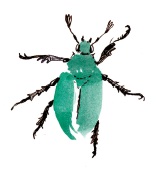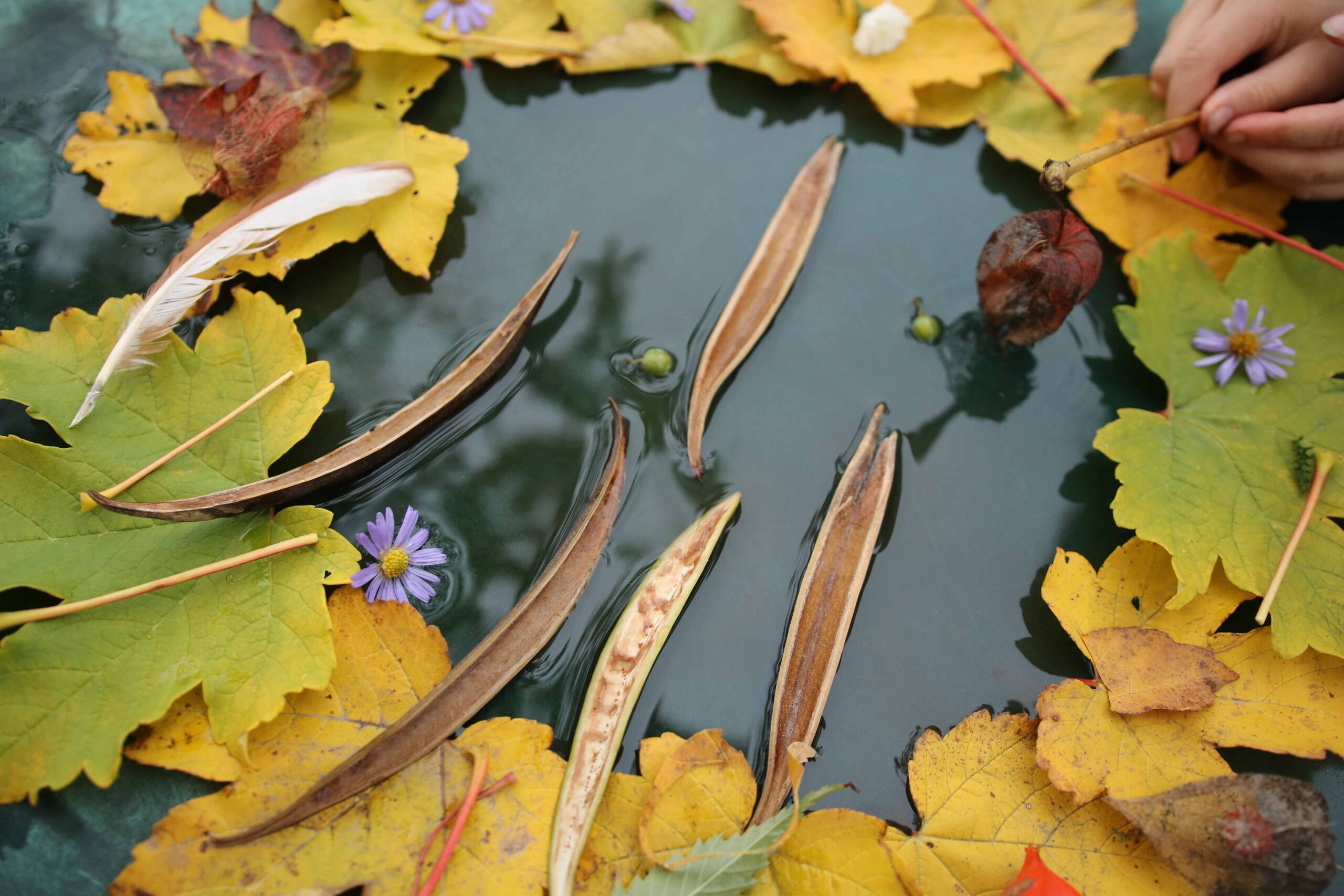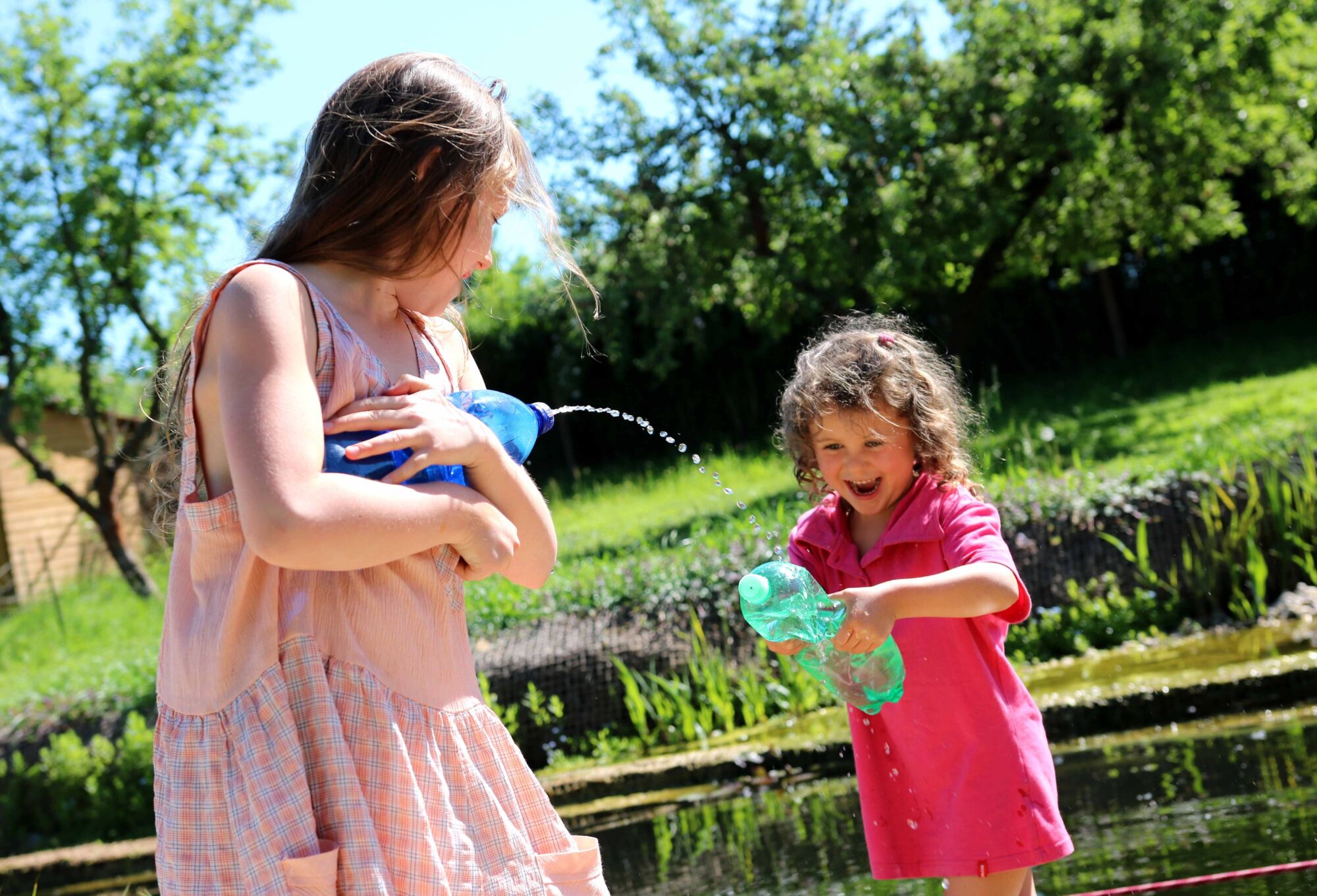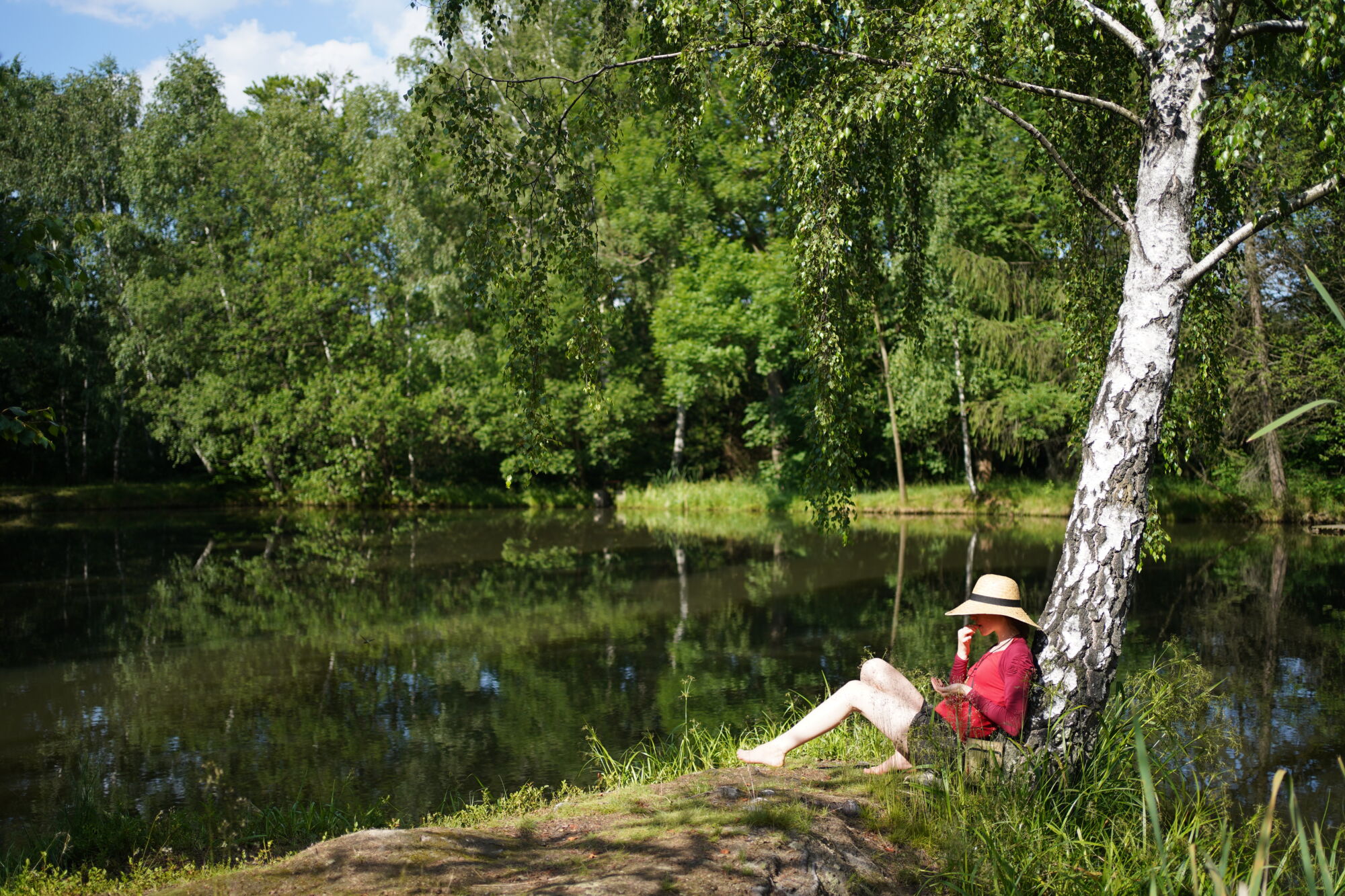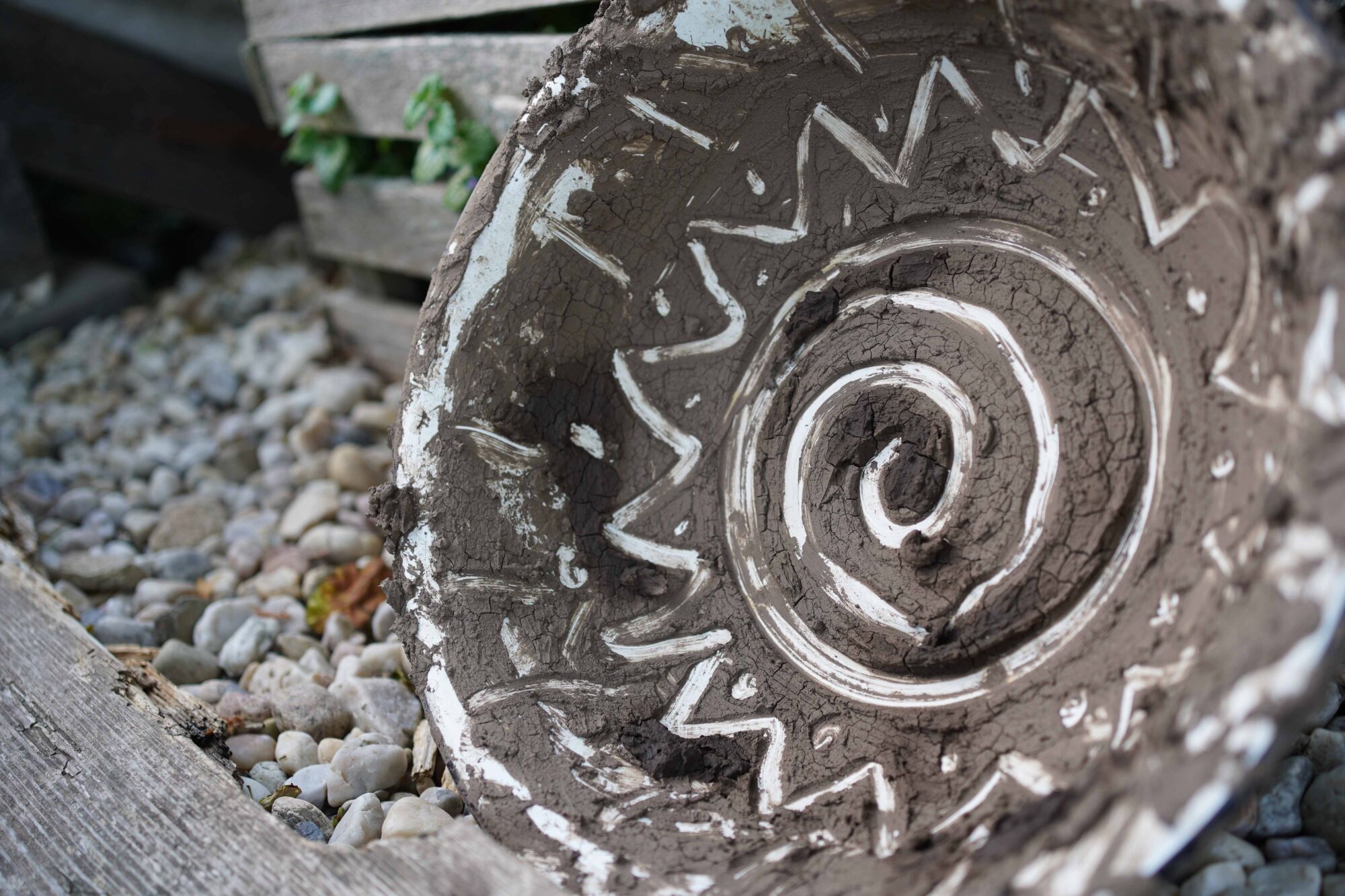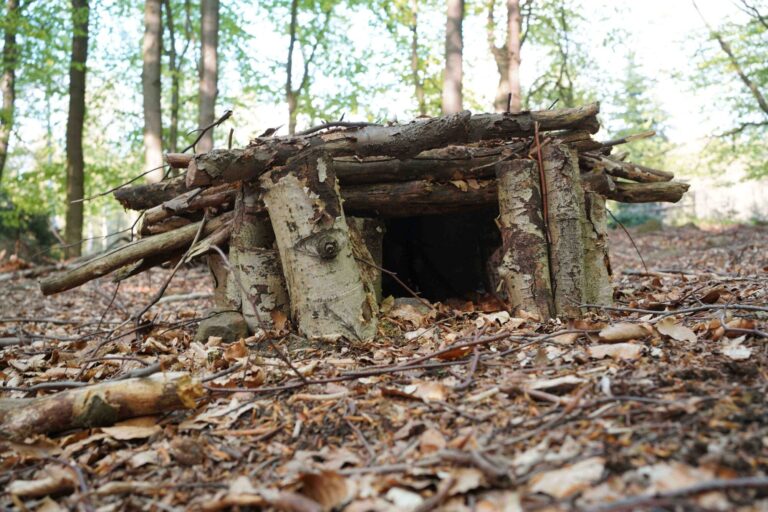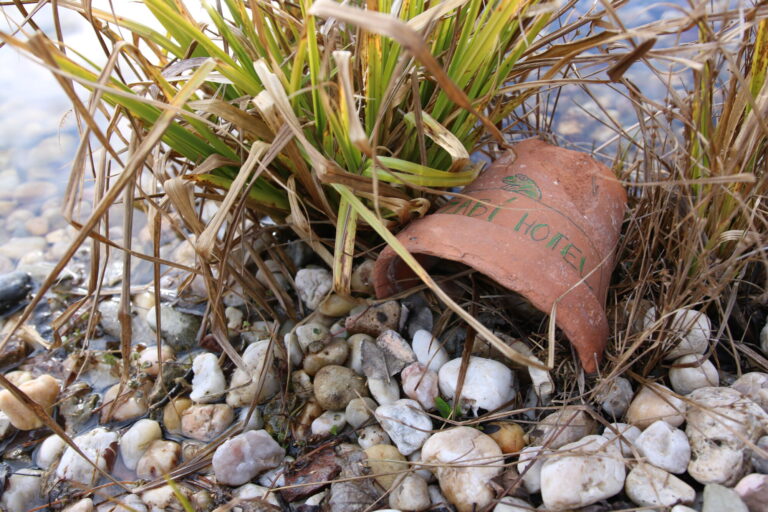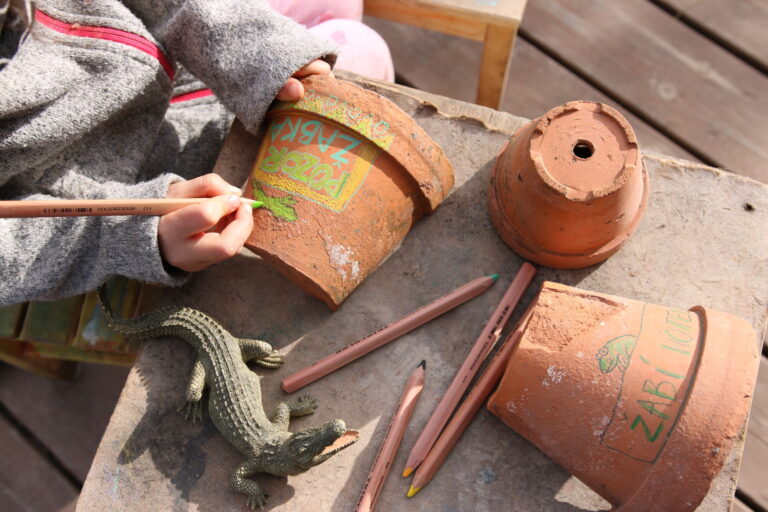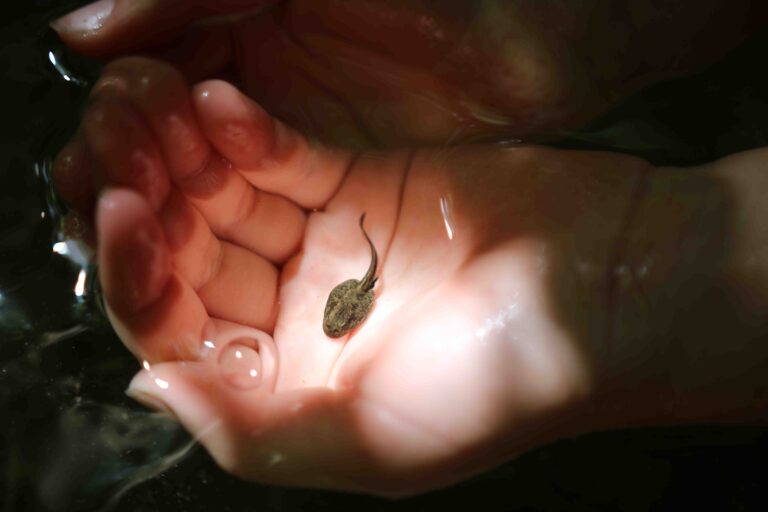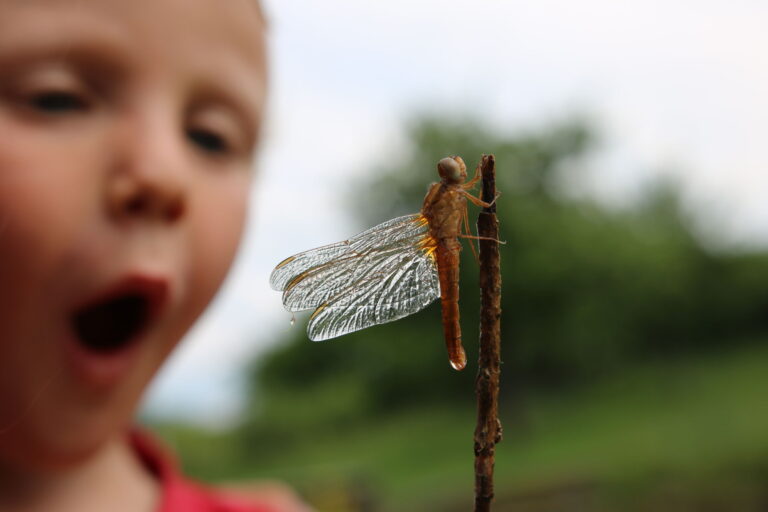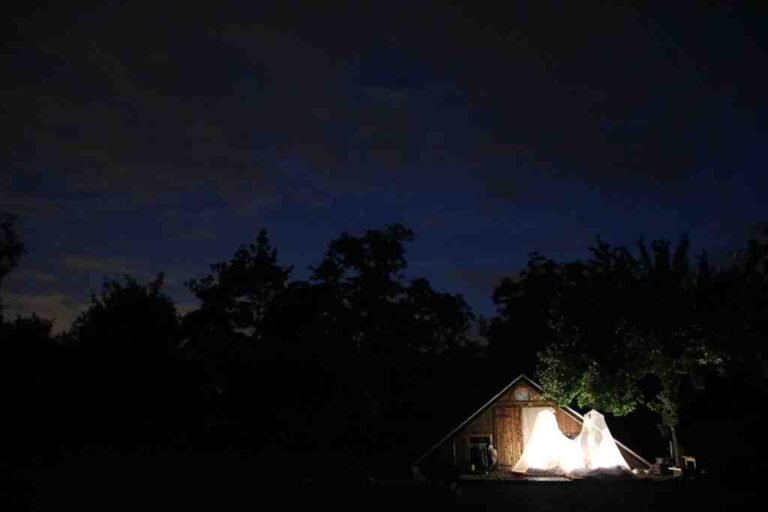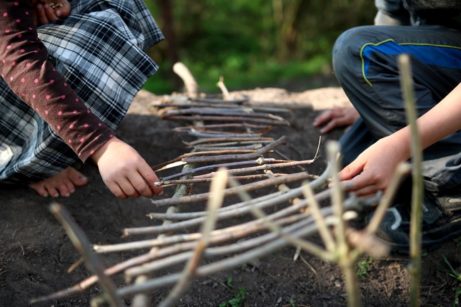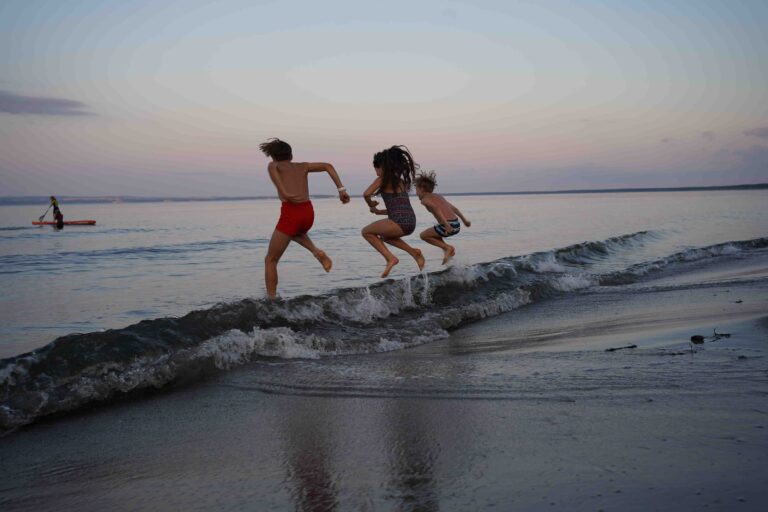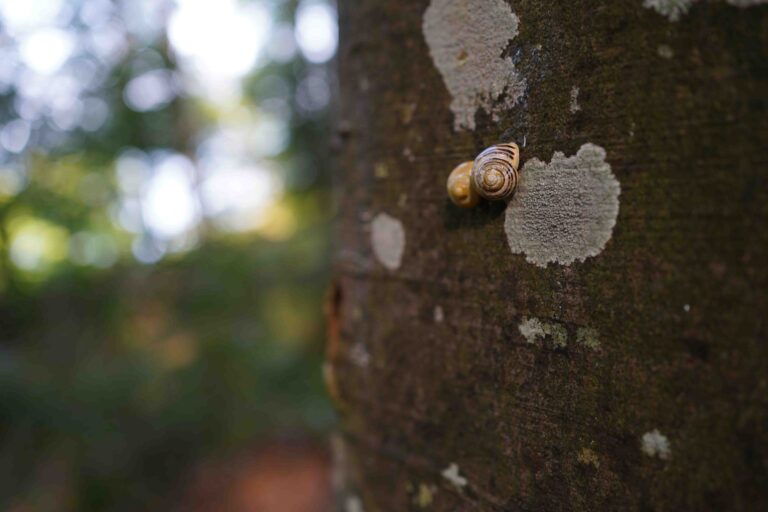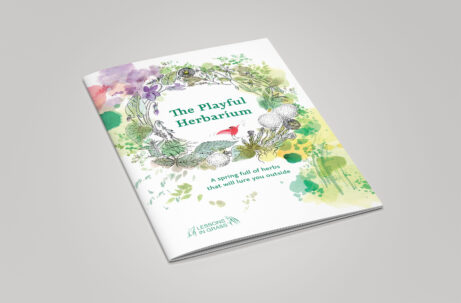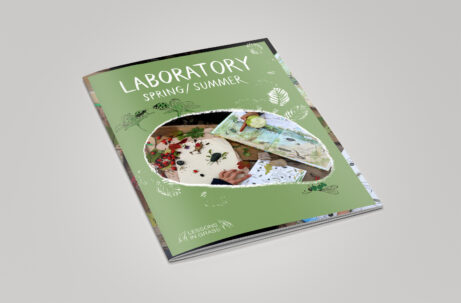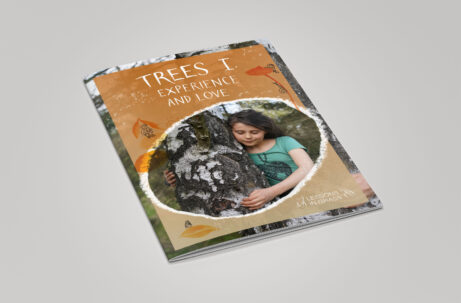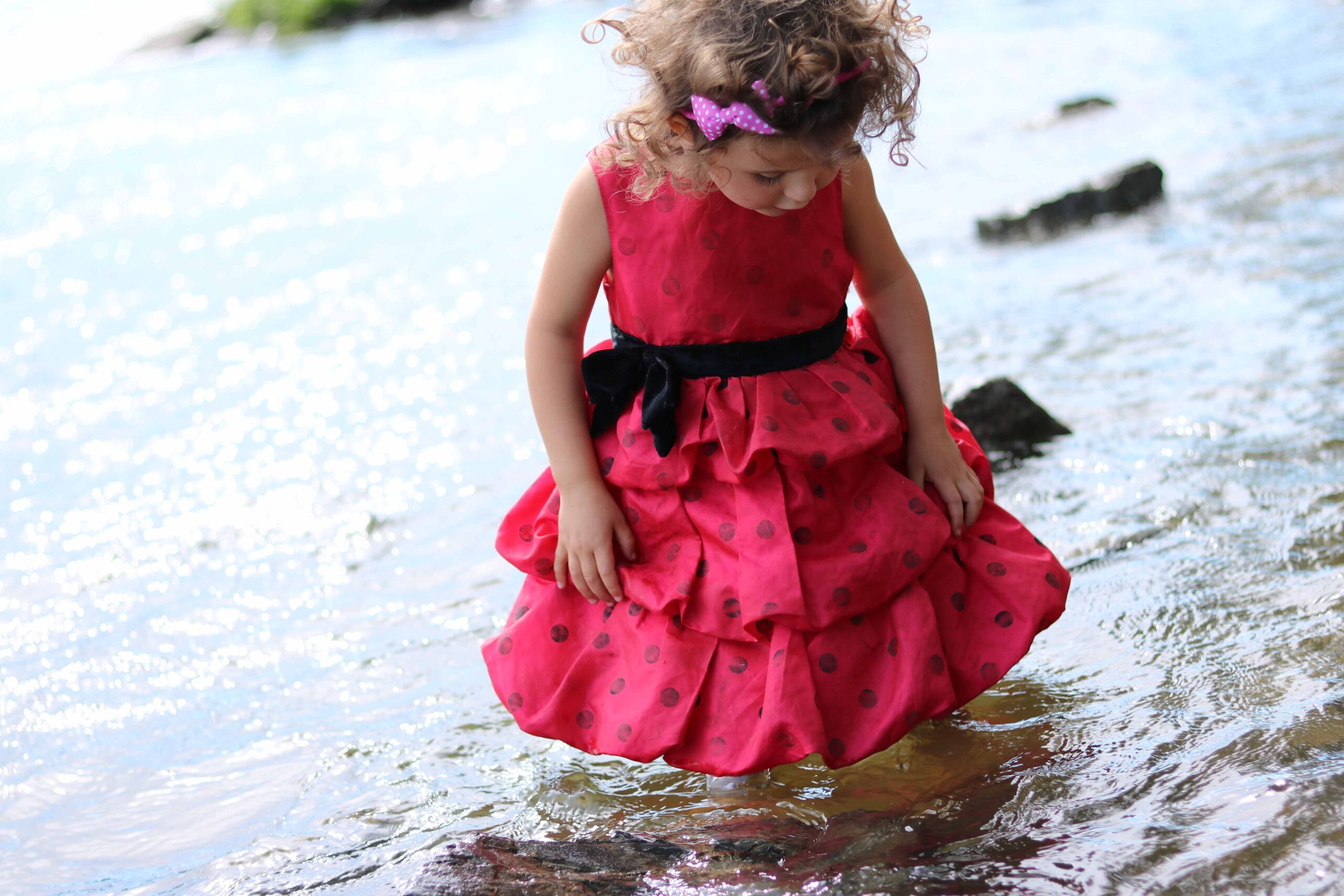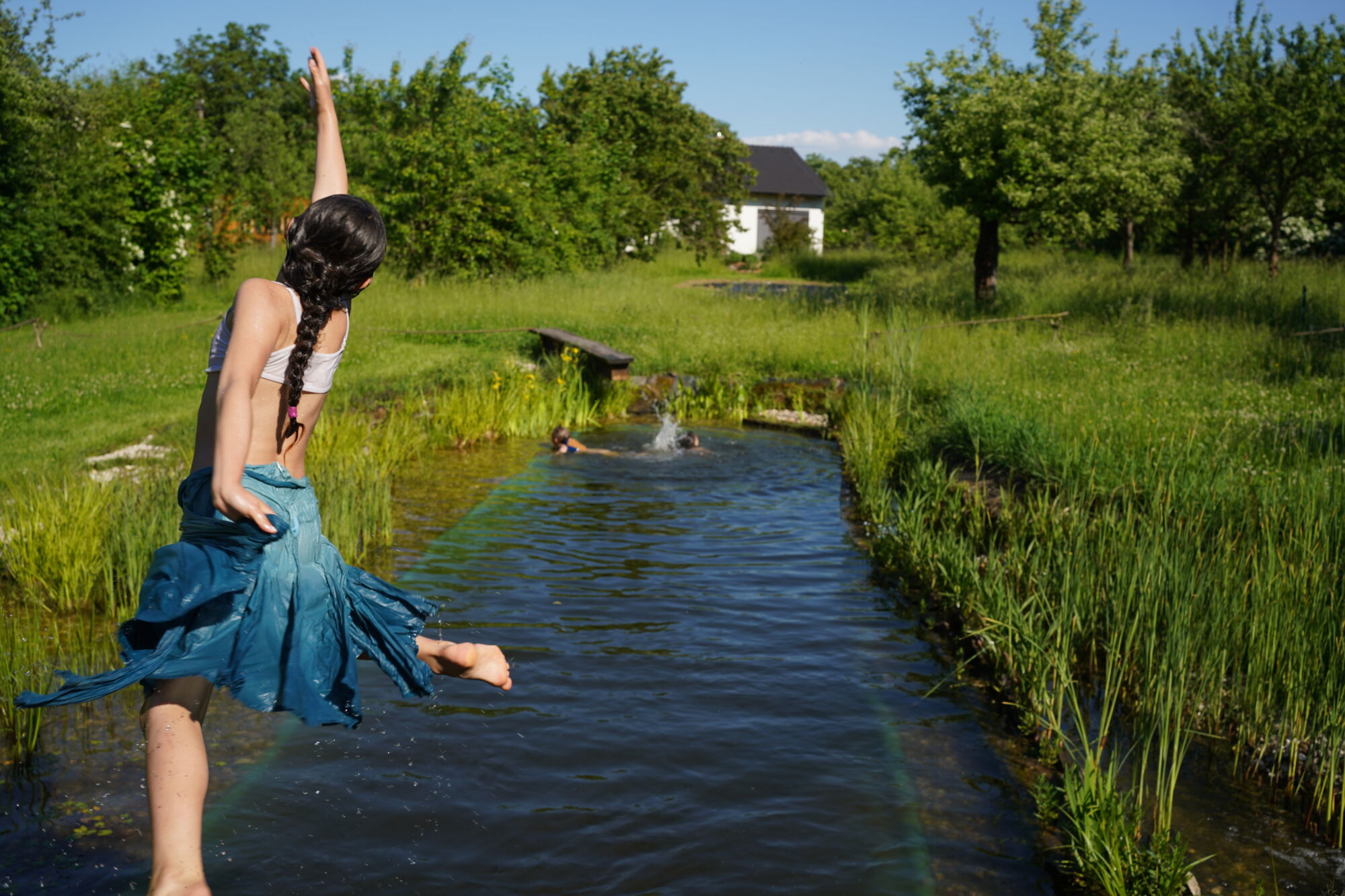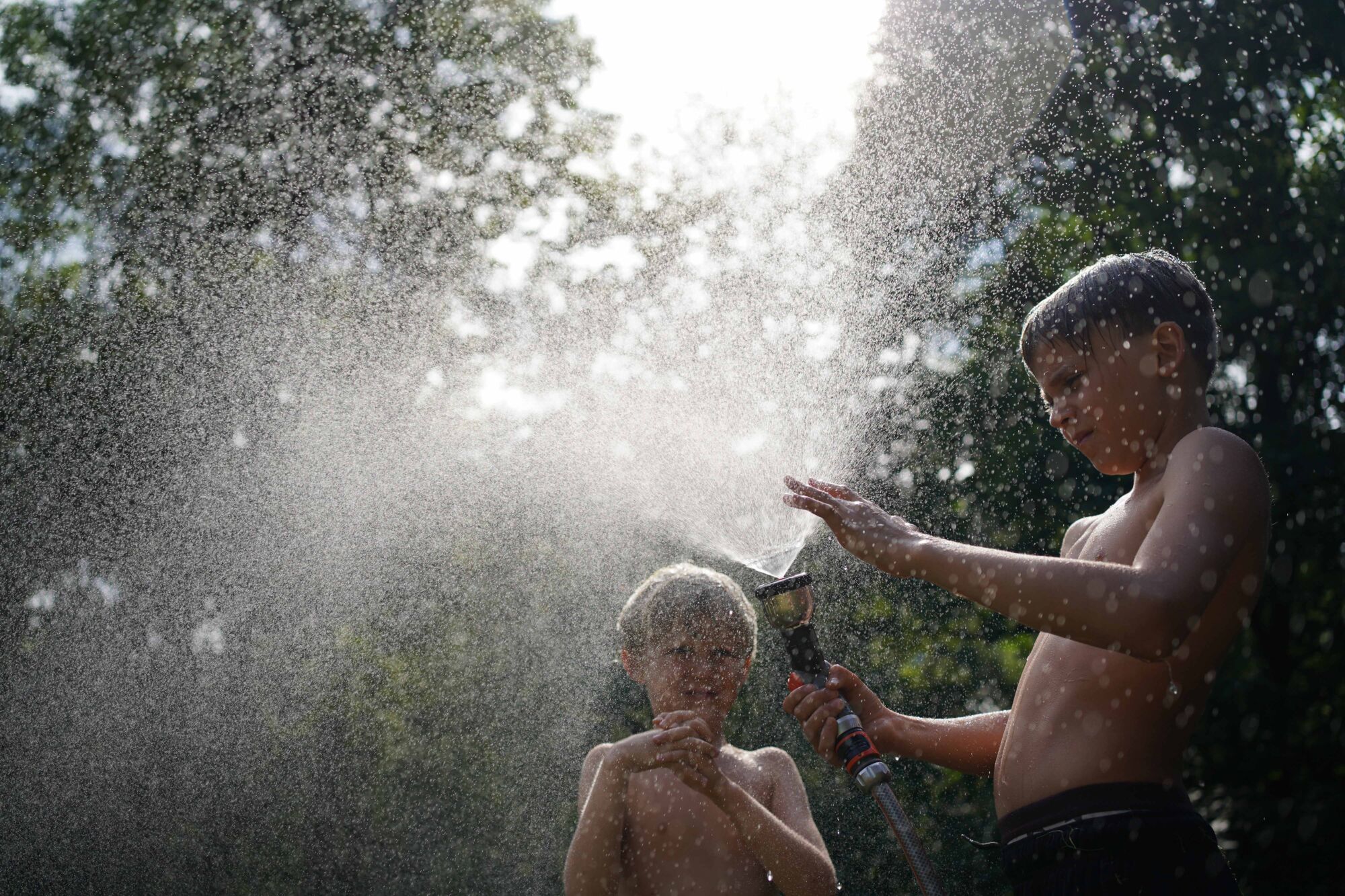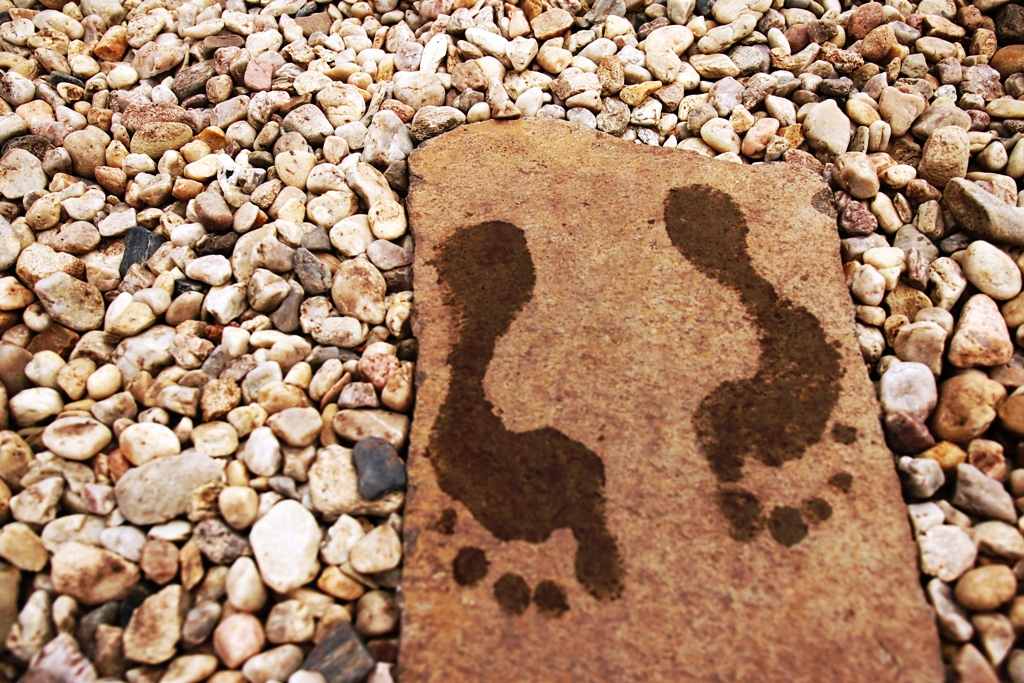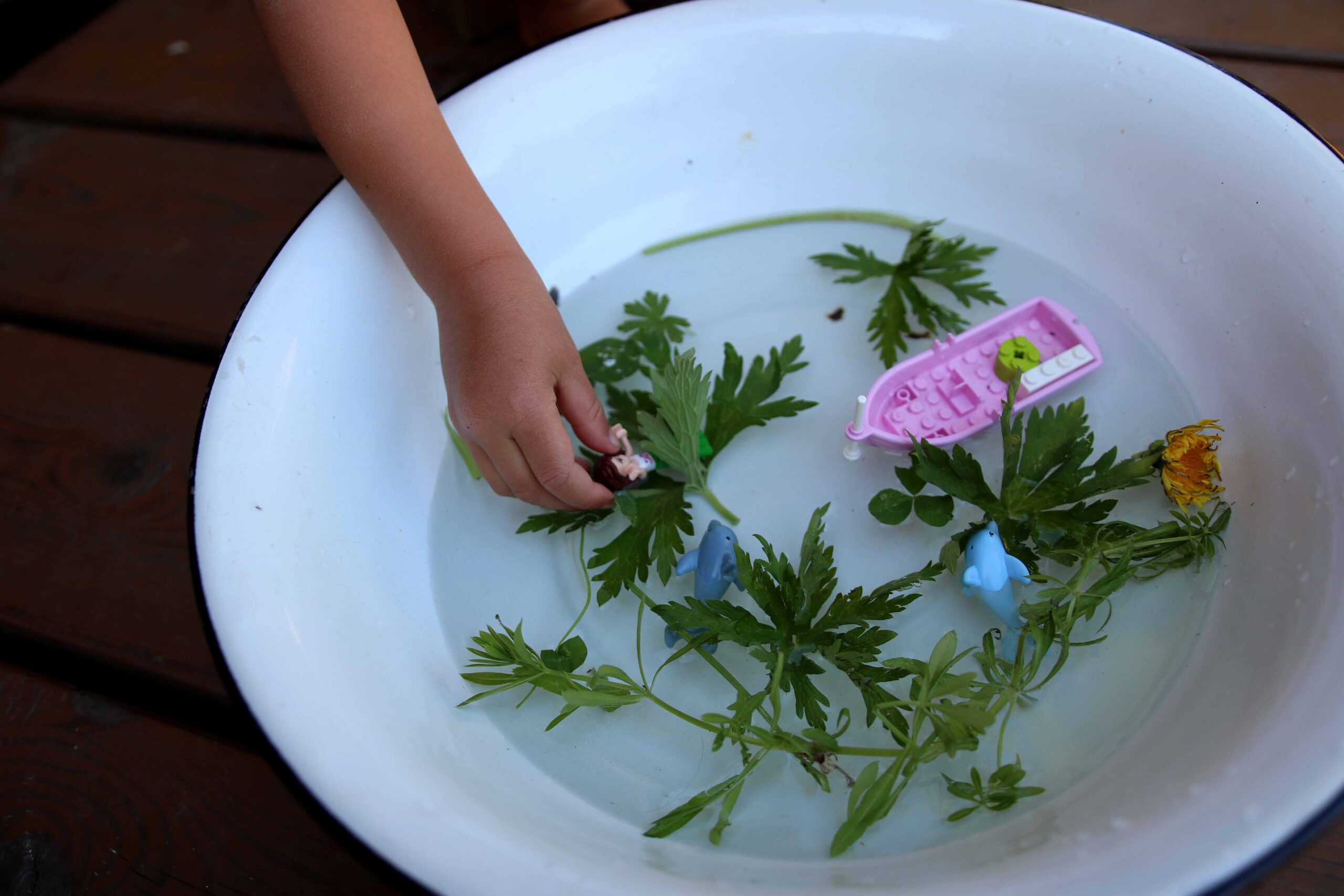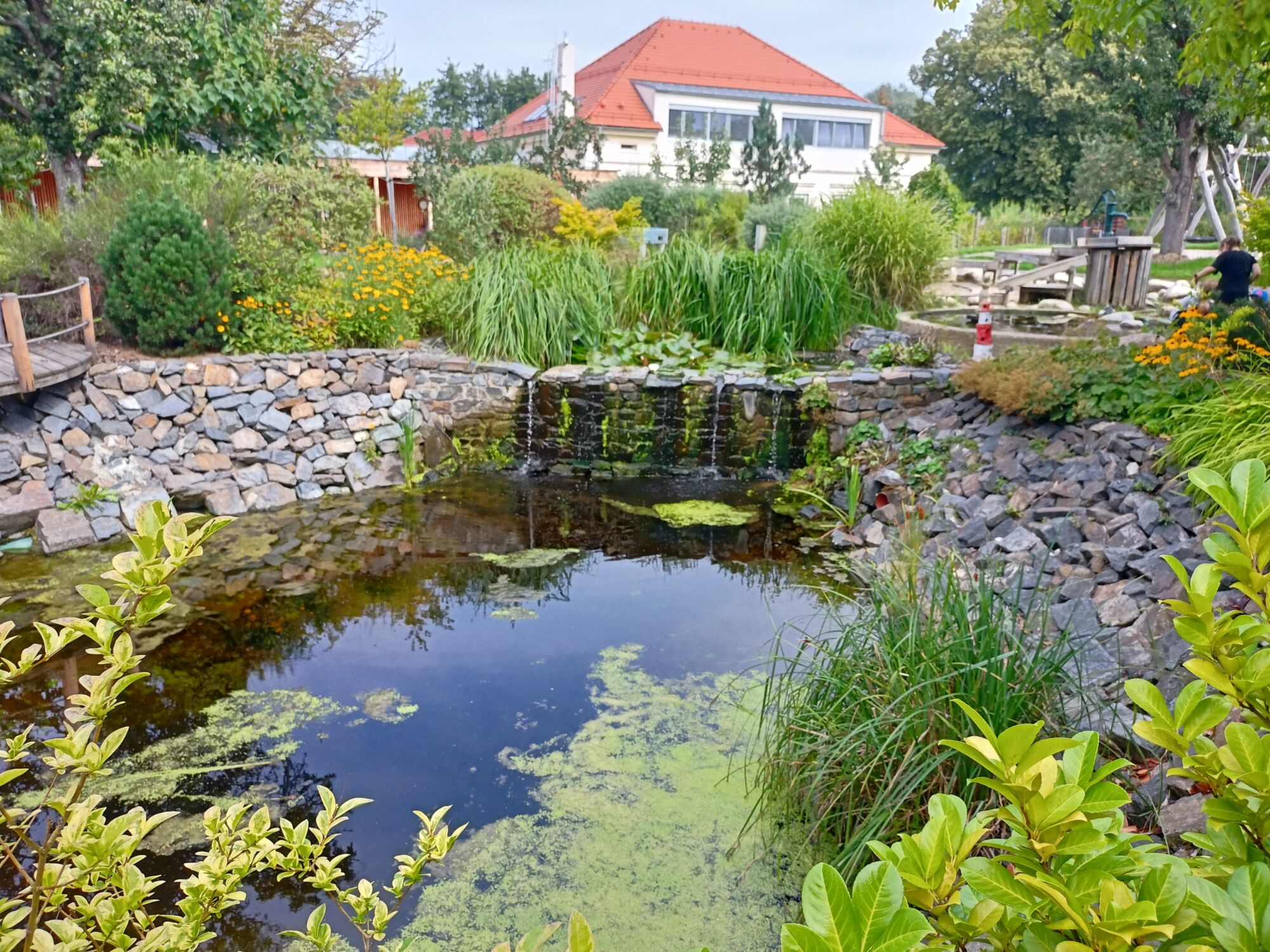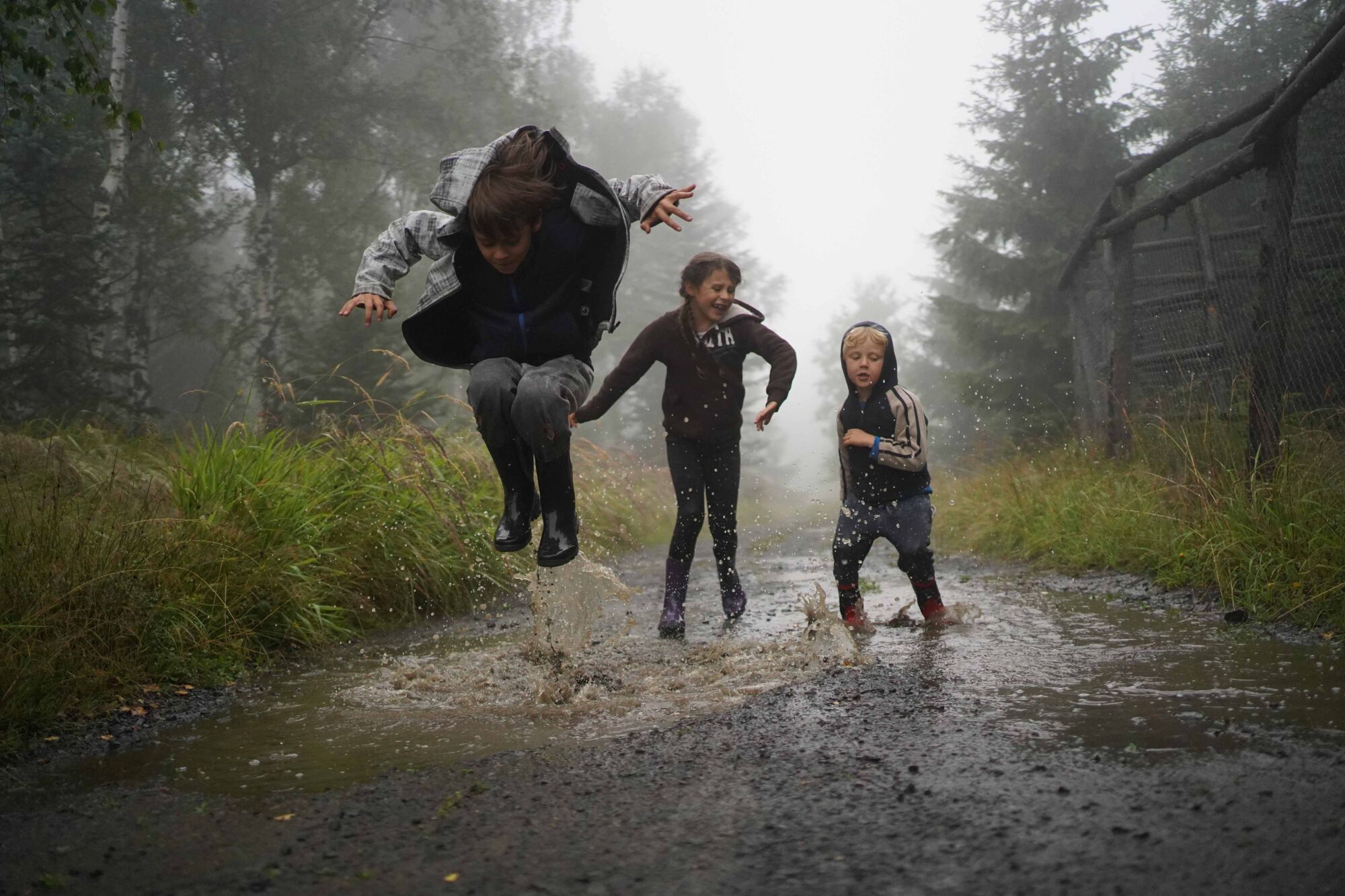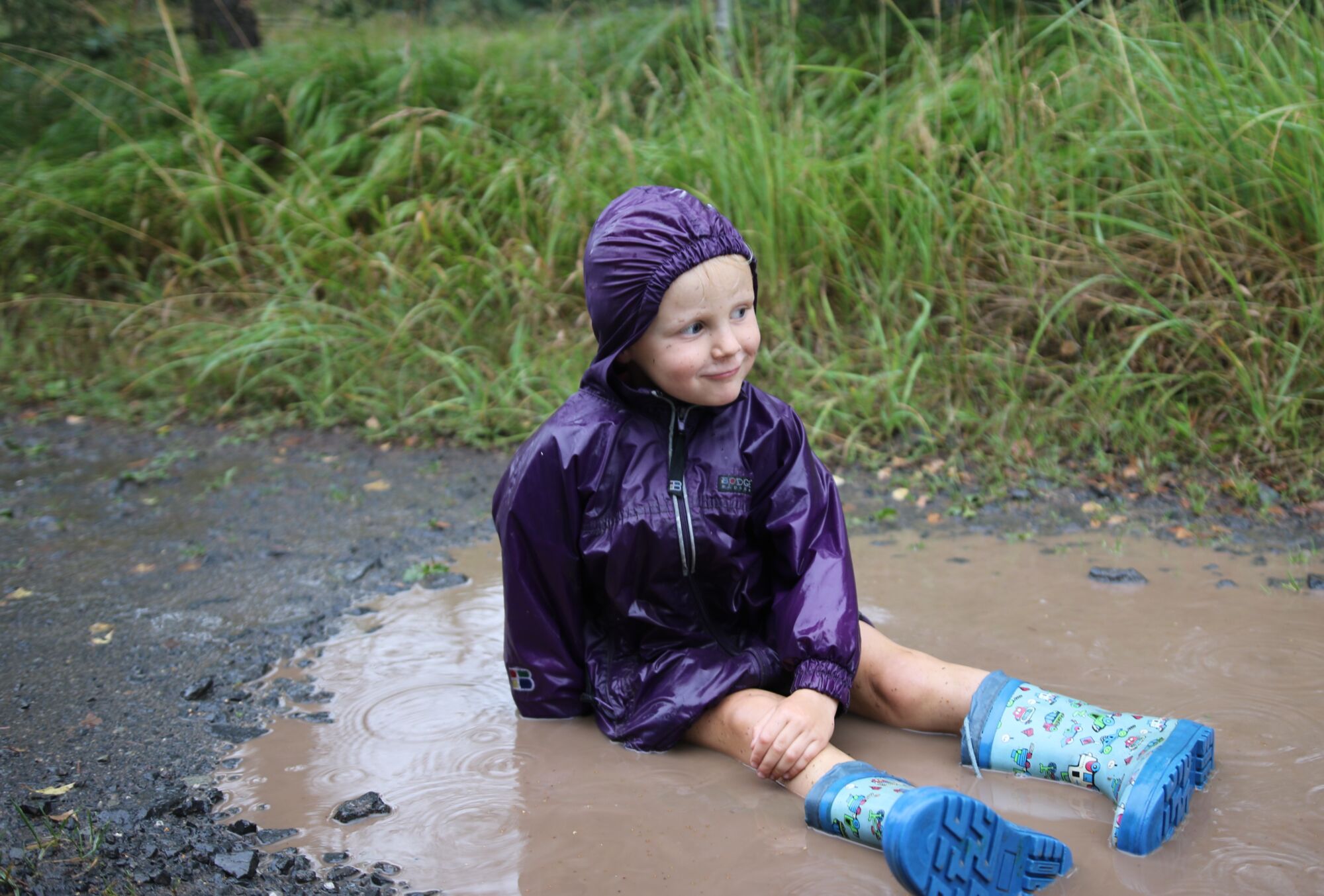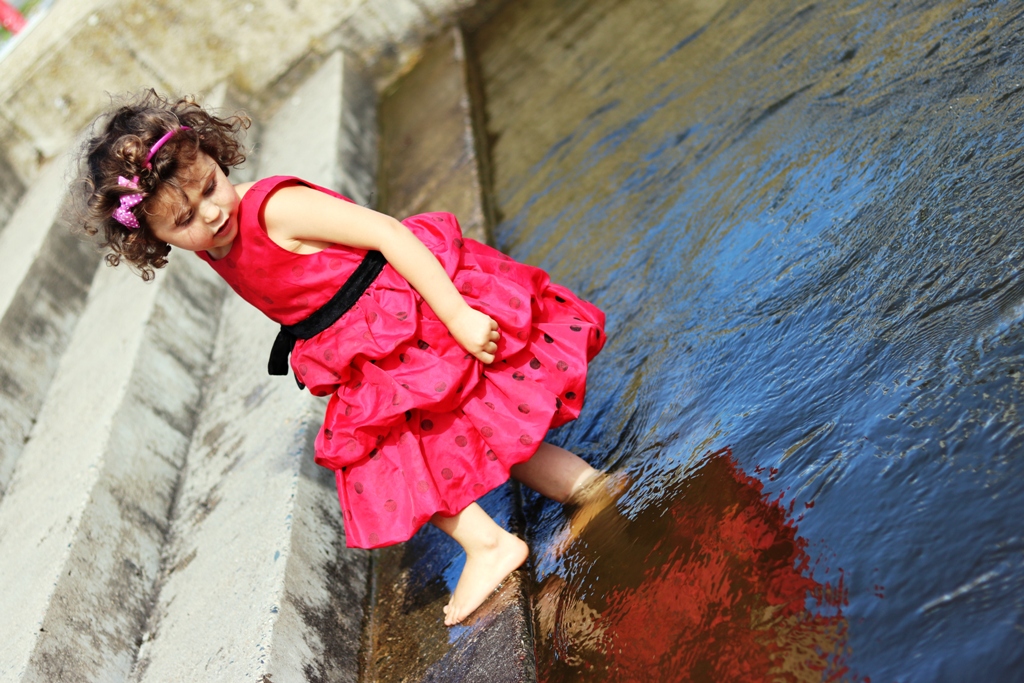
30 + 30 SUMMER OUTDOOR CHALLENGES*
* These 60 challenges are inspired by the practice, play, frolicking and exploring with children outdoors with a little help from the British National Trust (NT), which protects and cares for nature and monuments. The NT compiled a list of 50 experiences that a child should have before the age of 12. Their list was compiled based on the findings of scientists that children up to the age of twelve form relationships with nature and their surroundings. All of this has an effect on whether or not and to what degree a child wants to care for and protect the environment (not only the natural one) around them.
You don't need to do all of them, relax! It's more about attempting and enjoying them outside. Better yet, use our guide as an inspiration to write your own list of outdoor challenges with your children that you can do with your family, friends, squad or anyone else you enjoy being outdoors with.
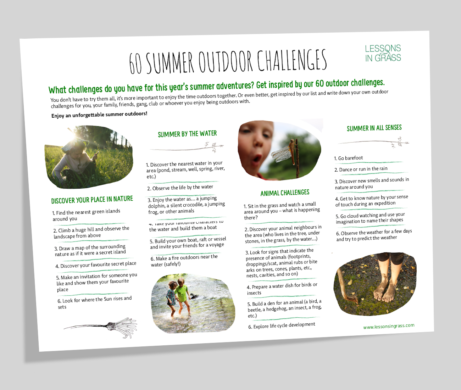

watch our webinars to get some inspiration and tips on
summer challenges
let's enjoy the summer outside to the fullest!
DISCOVER YOUR PLACE IN NATURE
Finding your place in nature is a crucial step not only for children but also for us adults∴
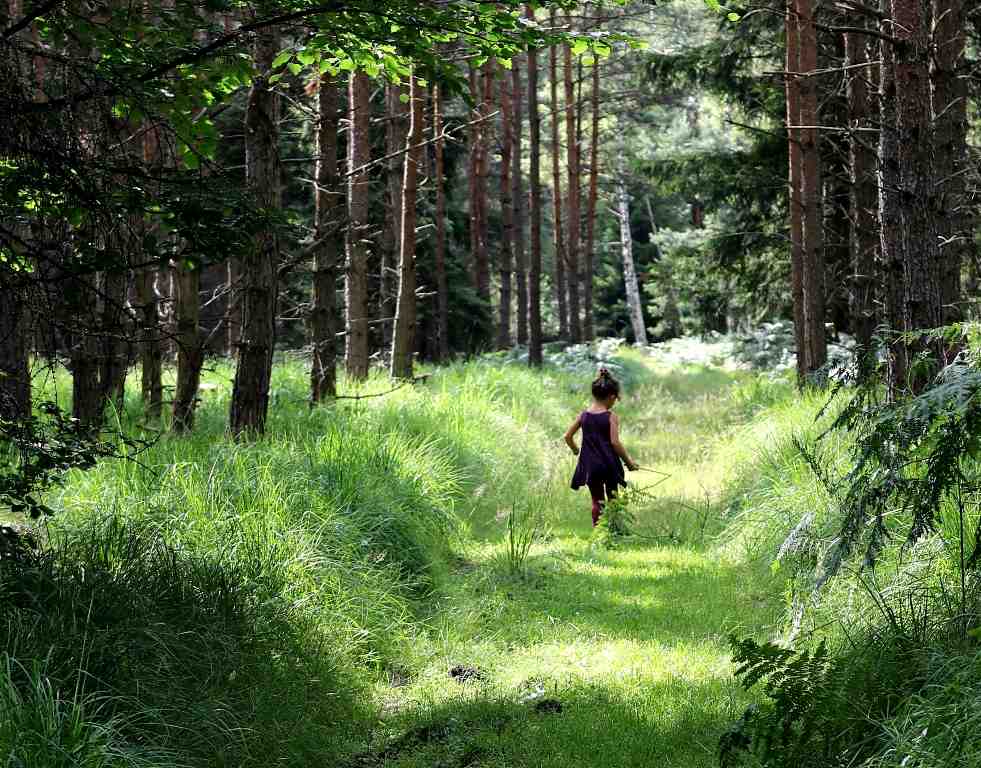
SUMMER BY THE WATER
Building and playing by the water often become our strongest childhood memories∴
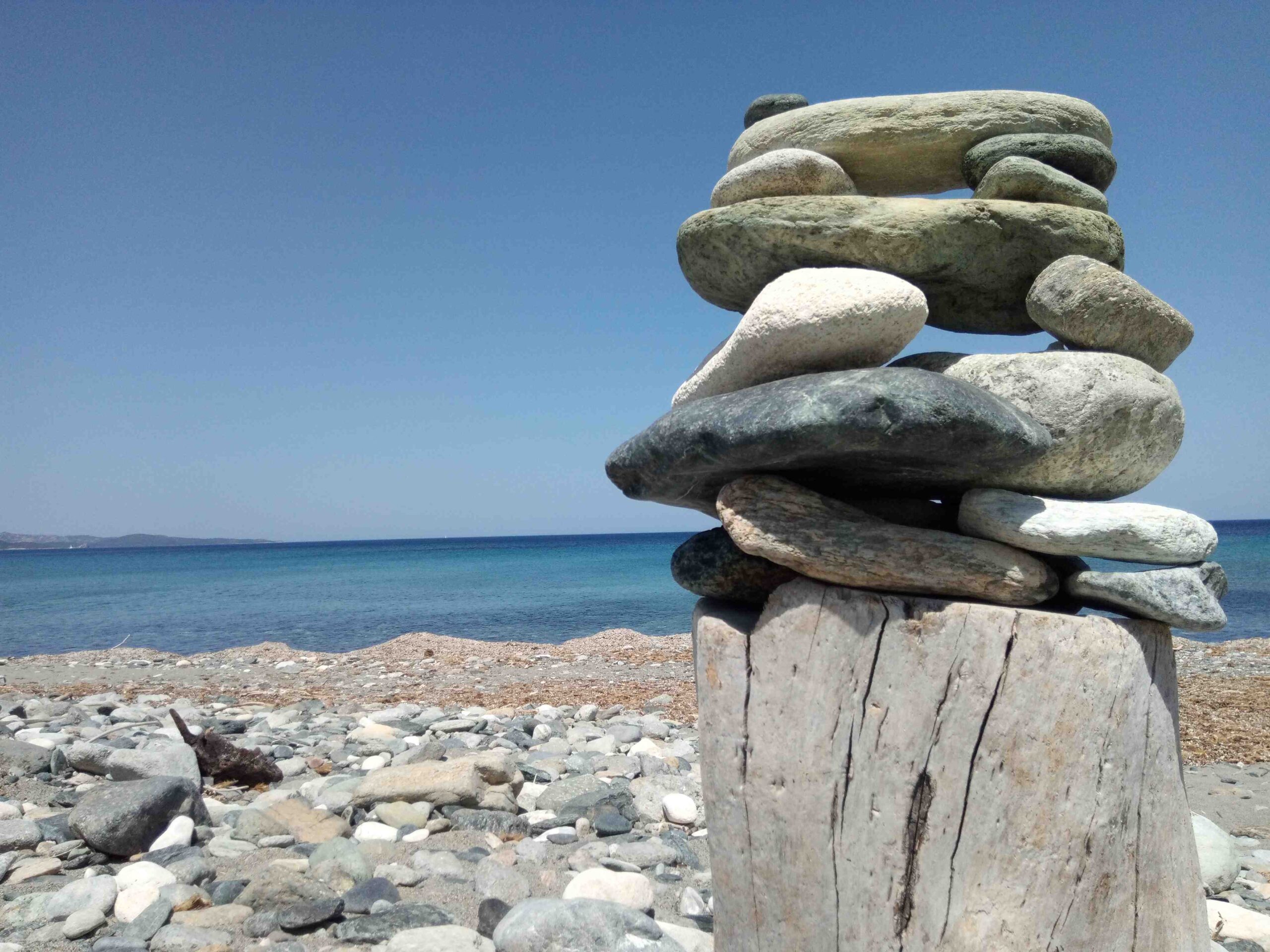
feel summer with all senses
Learn to look and perceive nature differently and more than just a background on a walk∴

A SUMMER FULL OF ADVENTURE
The summer sun, warm wind in your hair and long days give us the strength to do great things∴
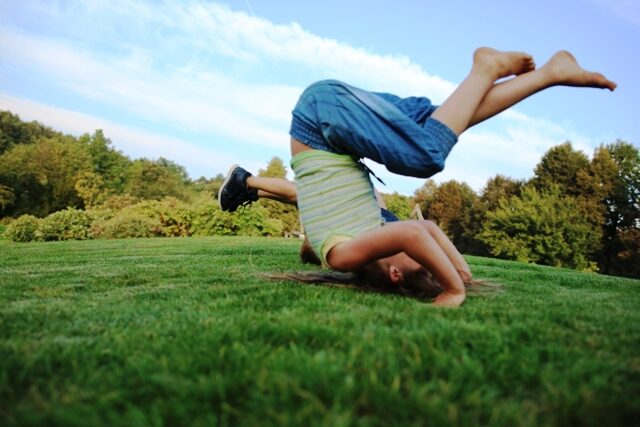
CREATIVE SUMMER
What is your favourite material? Try as many different materials, styles and crafts as you can∴
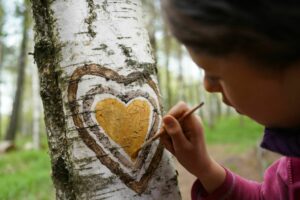
ANIMAL CHALLENGES
Quiet the inner hustle and bustle and opportunities for beautiful encounters with the animal world can occur.

NIGHT CHALLENGES
Summer nights are magical, mysterious, even mystical. Let the night draw you outside too.

SUMMER BULDERS
In the summer there is enough time for making elaborate constructions. Improve your design skills this summer!
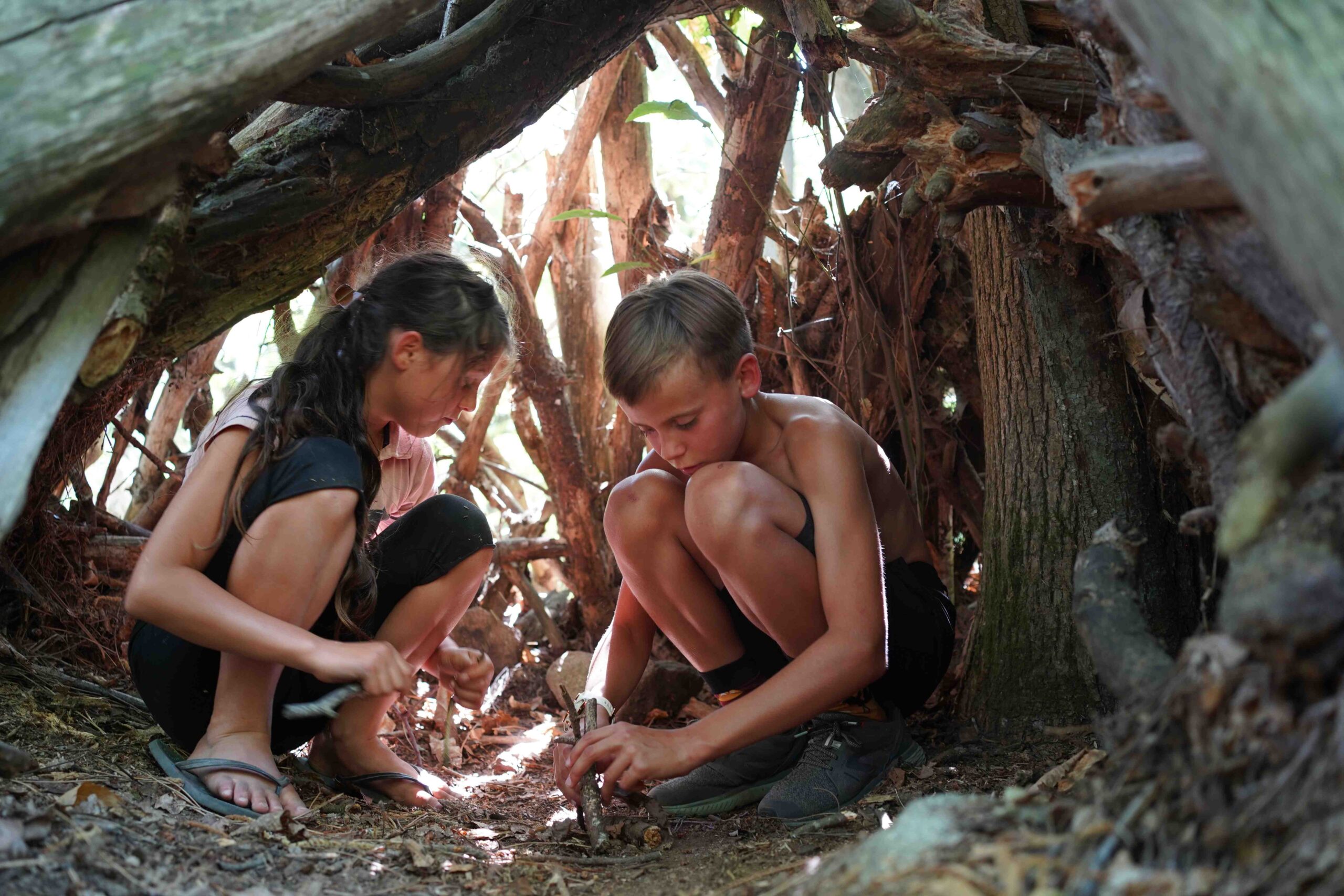
FIGHTING SUMMER
Fighting is a big part of playing so definitely add some battle elements to your games.
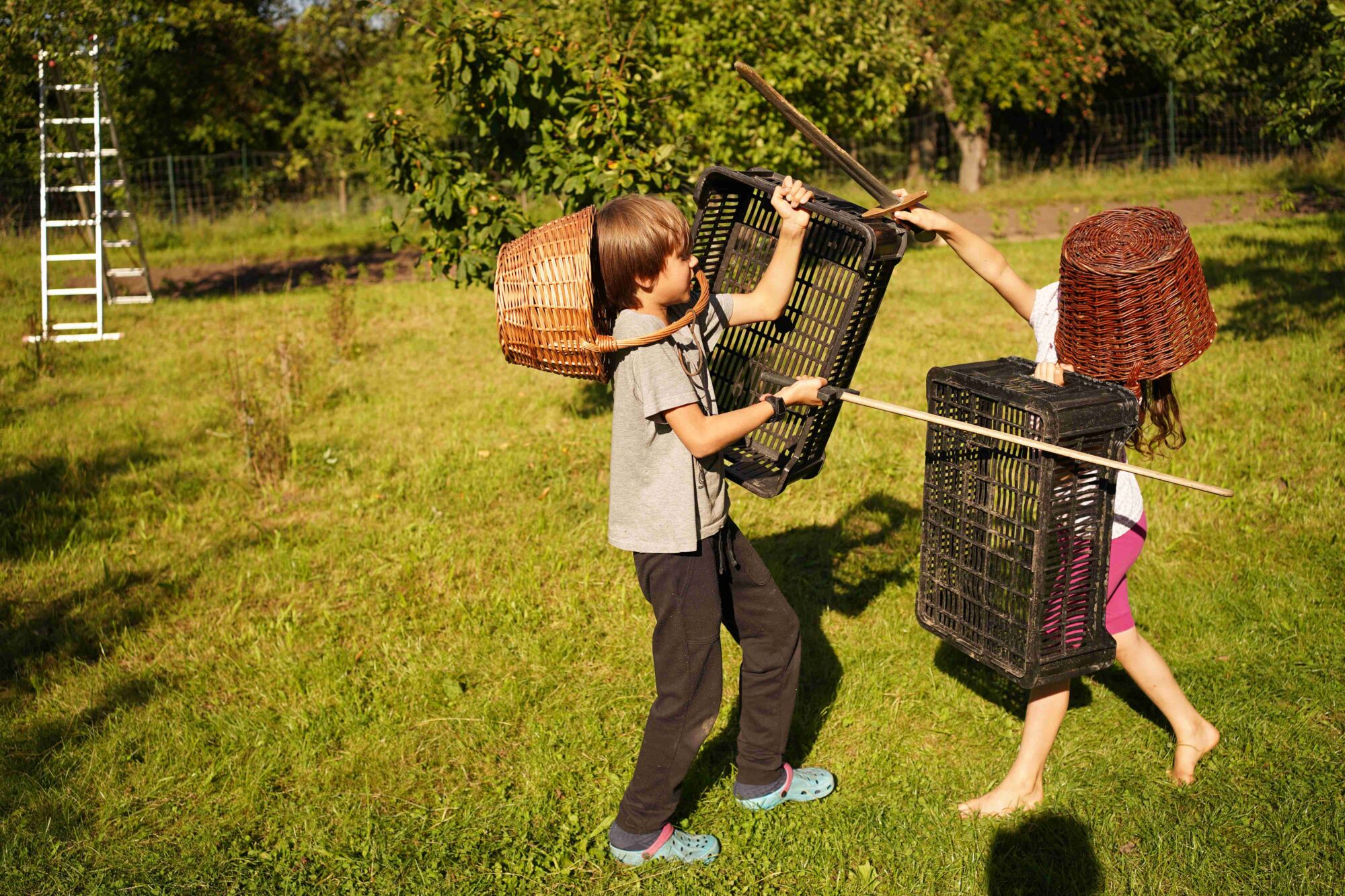
TREE CHALLENGES
Trees and their shade are essential for us in the summer. They are also great for climbing, for our hiding places and dens.

BONUS: WATER CHALLENGES
One never has water enough, huh? A complete guide to summer water adventures:)


"I had never really thought about letting the boys firstly play with water and usually go straight to trying to learn about it scientifically. You have really helped me understand that play is truly learning, and without this, a vital aspect is being missed out, and the connection for learning is missed."
Amanda Cadman, Great Britain

Finding your place in nature is a crucial step not only for children but also for us adults. Do you have your favourite place in nature? Where is it? How often do you go there? How does it make you feel?
Children should be supported so that they can explore their natural surroundings and find a space which makes them feel good. A fundamental relationship between children and nature is created this way. Children can feel more secure thanks to their place. Like at home.
A favourite place is ideally somewhere "beyond the front door", a short distance from home or on a regular walking route. But it is possible to have it at grandma and grandpa's or places you go to repeatedly during the year.
As children grow, their favourite place often changes. It's okay, their needs, interests and games outside do too. What is important is that they have the desire and skill to find their place in nature.

1. find the nearest islands of green around you
This is an easy challenge to start with. Look around and map your nearest green spaces. Use a map or the internet to help plan your trip. But most importantly, go out and experience it. You can take pictures of what you find, draw the green spaces on the map, discover what is out there and to where you want to return.
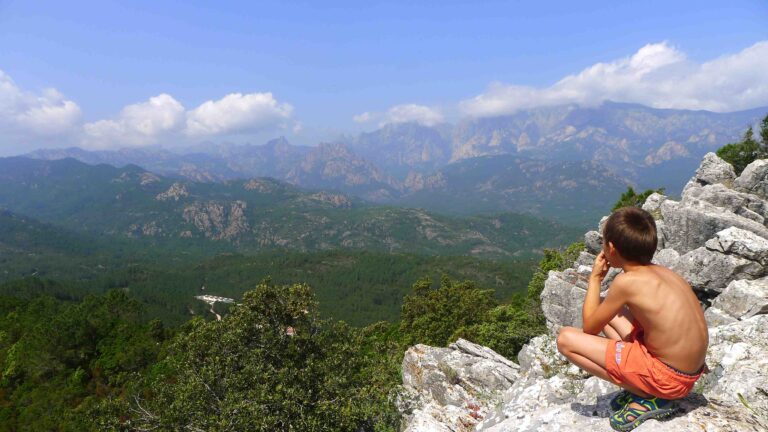
2. Climb a big hill and observe the surrounding landscape
Where is the highest hill, rock or lookout tower around you? Try to visit these tall places and climb to the top then look around you and try to discover more interesting green spaces where you will want to go on future expeditions. What does the landscape around you look like? Is it flat or wavy? What is on the horizon? What are the clouds like today? Write down, draw or take pictures of all that you can observe (how about into your new outdoor notebook?:-)).
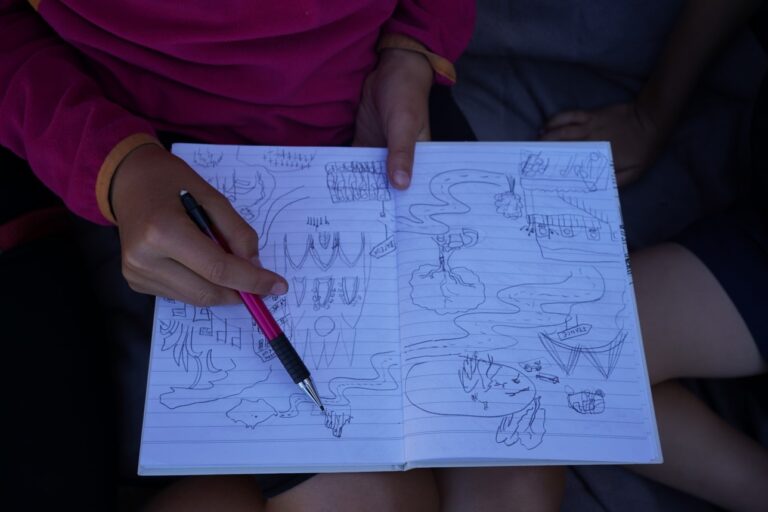
3. Draw a map of the surrounding nature as if it were a secret island
Imagine that the green space where you go for walks has become an island and you have to draw a map of it. Add names too of what is there and what could or should be there. Invent new mysterious places or creatures or magic that are there. New and wonderful games will be created in such a mysterious place.

4. Discover your favourite secret spot
You have already discovered and experienced a lot in your area, now try to find your secret place. No one will know about it. It's pretty hidden so others won't notice it; they will just walk on by. You can secretly hide something rare that is close to you there. You could hide, for example, some natural object like a carved stick. Draw a secret treasure map with a route to your hidden place but hide it well so that no one can find it!
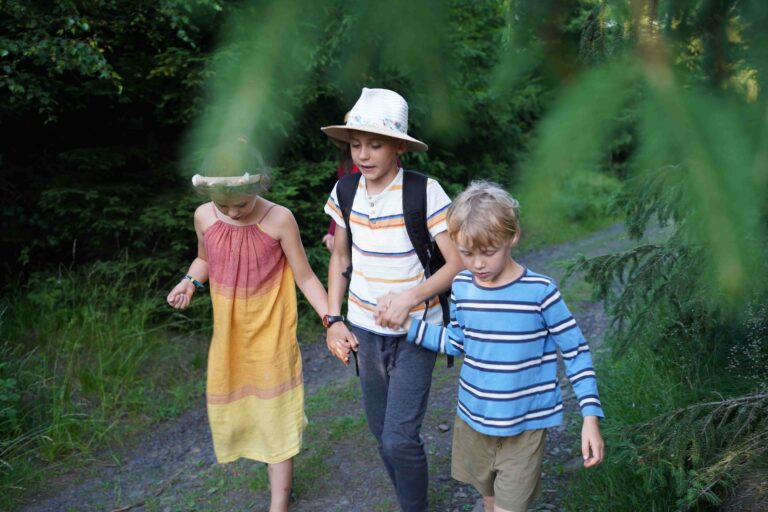
5. Create an invitation and invite a loved one to your place
It is beautiful and magical outside. How about experiencing favourite places with others? Make a list of close friends with whom you want to go to your favourite green places, islands and vistas all at once or one after another. You can also organise a picnic or a game. Create an invitation and let everyone experience these magical green places.
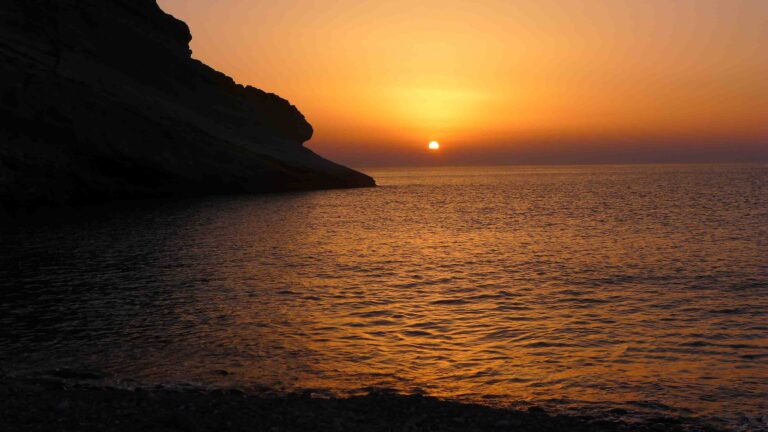
6. Watch the sunrise and the sunset
Every experienced traveller not only observes the “place”, but also how the sun travels across the sky every day. Get up one morning and map out the place where the sun rises. Then plan an evening meal on another day, take a walk and try to find a place where the sun sets. Write, draw or put a photo of everything you observe into your outdoor journal. You can compare your observations during different months and years.

You can’t have a summer without water. The heat of the sun and the cool of water are a perfect match. Put them together in your games and explorations. Water isn’t just for swimming and cooling off. Try to observe it, invite it to your games and stories. What new things will you experience when you just add water? How will this help with your skill and ability to plan? Return to your water regularly. Observe its changes, hues and sounds. Test how strong the element is. Building and playing by the water often become our strongest childhood memories. Leave plenty of time for your summer aquatic experiences.
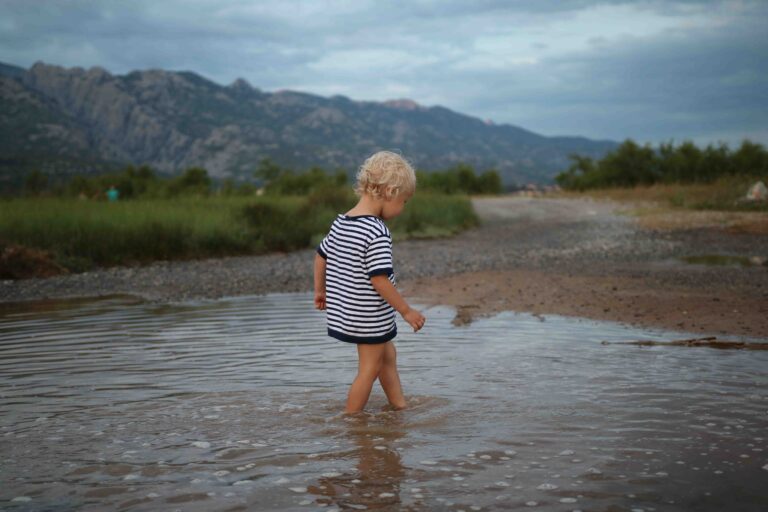
1. Discover the nearest water features in your area
During your outdoor expeditions, you should definitely try to discover sources of water. Explore your neighbourhood to find the closest stream, pond, well, river or spring. Have a good look around the place. Pay attention to details. Guess how clear the water is, how fast it is and try to observe how the water affects its surroundings. Write everything down or draw or take pictures for your diary.
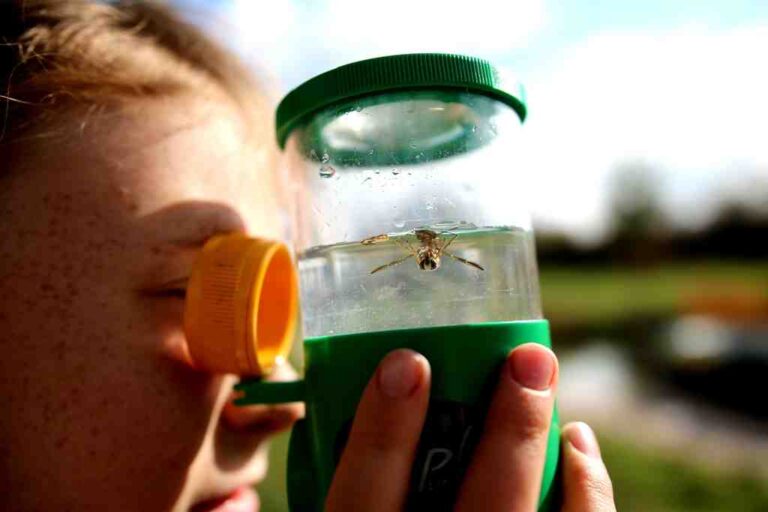
2. Observe life by the water
Water means life and there is usually life in it too. Explore what grows around the water, the traces of whatever moves on the surface, what floats in the water or who lives on the shores. Observe carefully but do no harm. You can pack a few tools with you (a bowl for water, a magnifying glass, a fine paintbrush to move fragile animals with, identification charts, etc.). Record what you discover, where and when. Feel free to get inspired by the lessons on our website.
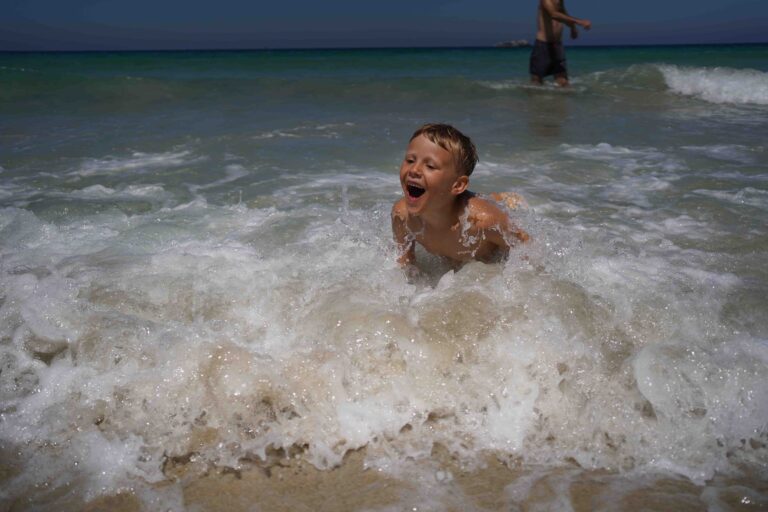
3. Enjoy the water as...
Transform. You can be a leaping dolphin, silent crocodile, jumping frog or other animals. Experience the water for yourself. That is, with your own scales, feathers or carapace. Don't just go swimming. Try moving in the water as various animals. How do they move? Where do they look for food? How long can they swim underwater? Who are they trying to escape from? In what ways do they enjoy water?
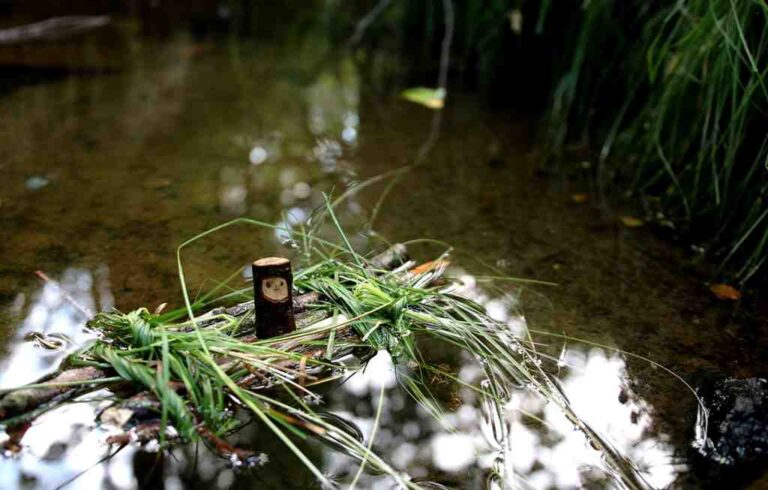
4. Take your favourite characters to the water
Small worlds by the water come to life in spectacular scenery and games. Add your favourite figurines to the water and let them have a water adventure. Build a raft or a super boat for them. Take them on a cruise or have them camp on the shore. What can they experience there? Make up your own story. Maybe they were shipwrecked or found a mythical water creature or maybe they are saving a spring from drying up...
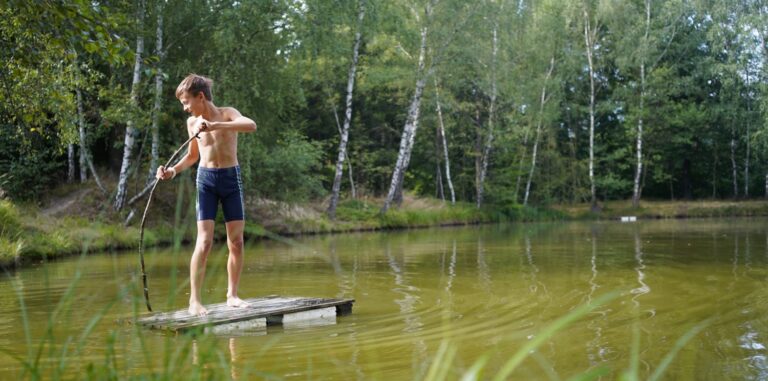
5. Build your own boat, or raft (and invite friends to sail with you)
This is a bigger challenge. It takes experience, materials and maybe even a crew. Design and test your own watercraft. What will make it float and how? What will help you? Explore the internet or, ask an adult if you are unsure. It might be a way to gain additional allies for building and testing. Test it in shallow waters where you can reach the ground in case it doesn't work out right away. Persevere. There is plenty of time to make it work in the long summer.
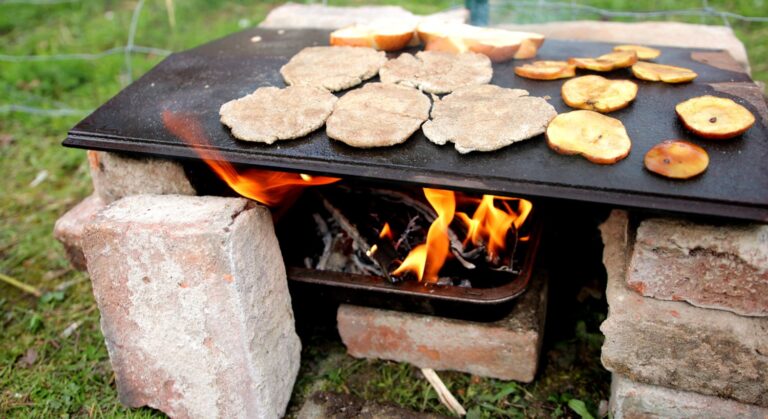
6. Make a (safe) fire outside near the water
Evenings by the water are unique. Watching the calm water or the ripples on the surface. There is life all around. If you can, try to start a fire by the water. Find an experienced guide and learn from them. There is always water close by in case of an accident but a small fire is enough. You need it to be just a few centimetres high to make your figures in the small world happy. It is important to experience these two elements side by side.

Stuck under a roof and between four walls we are a bit like domesticated pets. Our senses become lazy. Wake them up outside. Little by little, gradually increase your sensitivity to changes in nature.
Suddenly you are waking up as from a dream. You see, hear, and feel many more things. It may be gradual but it is definitely worth it. Learn to look and perceive nature differently and more than just a background on a walk. Make a note of the minor changes in the wind, or the sounds and even the tracks on the ground. Connect with our ancestors who, as hunters and gatherers, were hard-wired to the signals in nature. Plug into the natural network.
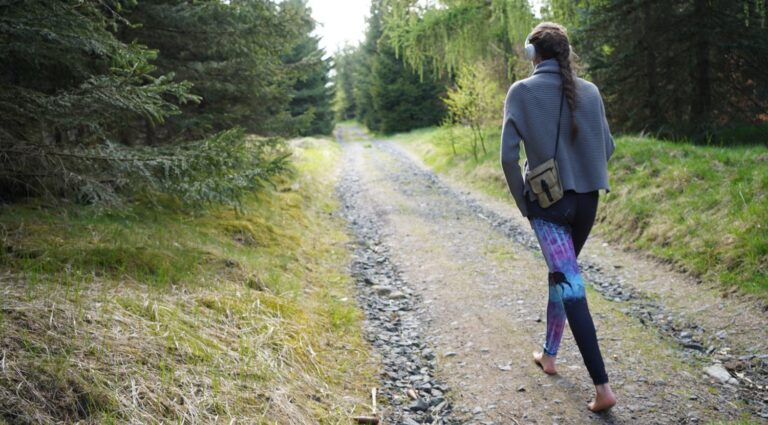
1. Walk barefoot
It's easy but we rarely do it. Take your feet on a trip outside. Choose a place which looks nice and discover what you can feel with your feet there. Observe how you slow down too, how you are more alert and careful where you step. It's an easy way to slow down and experience a familiar place more intensely. Draw your route or the surfaces your feet discovered while barefoot.
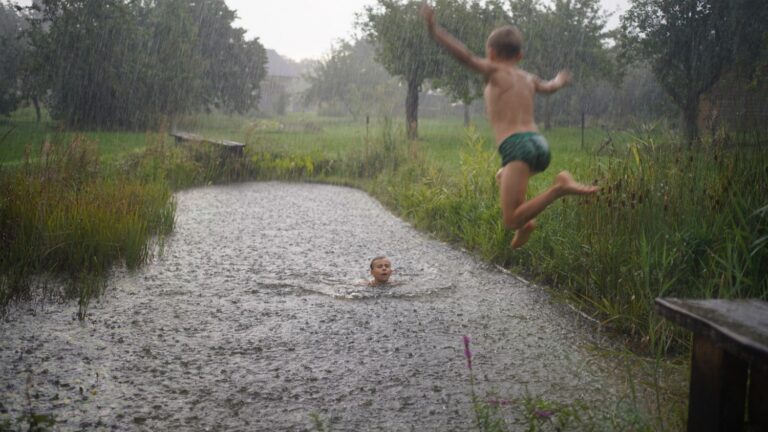
2. Run outside in the rain
When was the last time you were drenched and loved it? Was it so long ago you don't remember? Try it again. The next time it is raining outside and you are safe and comfortable at home so you have somewhere to change and warm up, just go out into the rain. Dance in between the raindrops or let them fall on your body and face. Taste the rain. Choose a pleasant rain, time and place which will make you feel good. It is also great to go out in the rain with the whole gang.
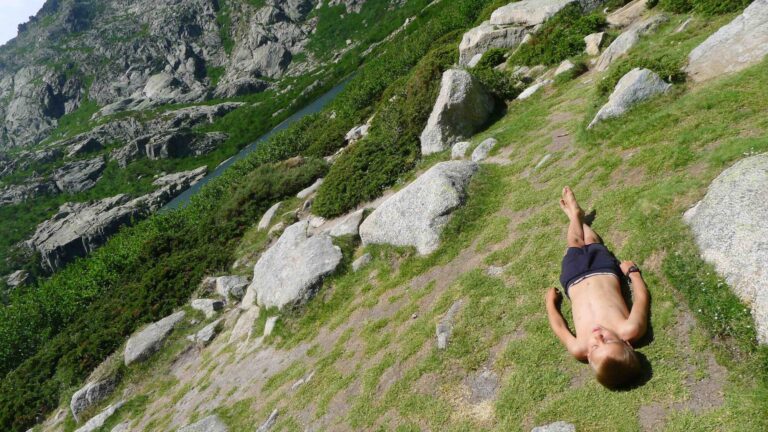
3. Discover new smells and sounds in nature around you
This walk is going to be a little unconventional. Feel free to walk a well-known route but this time focus your attention on things that are different from the usual. Try using your nose and ears to provide the senses that will guide you. Try to discover new sounds and smells. You need to calm down, slow down and go, ideally alone or in a quiet group. It will be great to write down your experiences quickly before they fly away.
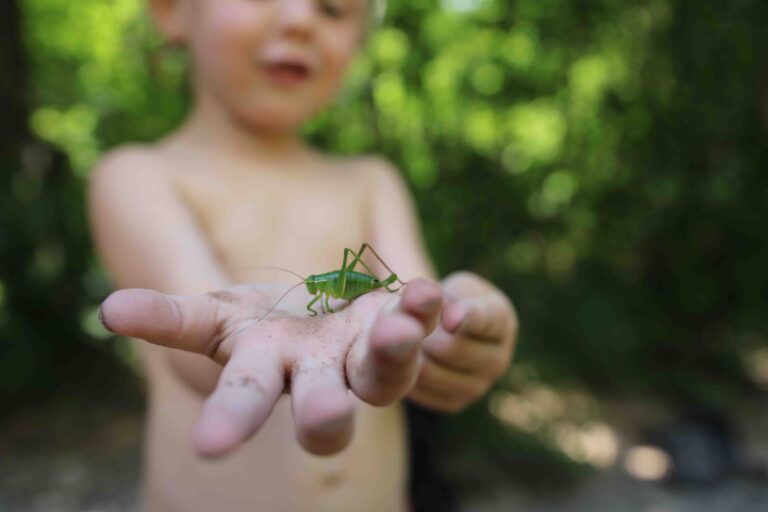
4. Get to know nature by touch
How about waking your hands up outside as well? When on your next trip, occasionally invite them to explore. Look around to find something to touch to feel something new that you haven’t felt before. What does the bark of the trees around the road feel like, what do various cones feel like, what are the textures of pebbles, how is the stickiness of clay or the temperature of the water? When you are with others you can play a guessing game during the trip. Put a pleasant object in the hand of someone else and they need to guess what it could be and describe what it is like.

5. Observe the sky and find the shapes in the clouds
This is a beautiful and relaxing game. After a long trip or running activity, it is time to rest. Get comfortable, lie down and watch the clouds in the sky. How fast are they moving? Where are they travelling from? What might they have seen happening on Earth? What do they remind you of? Talk about the animals, creatures, figures or places that you see in the cloud shapes with your companions.
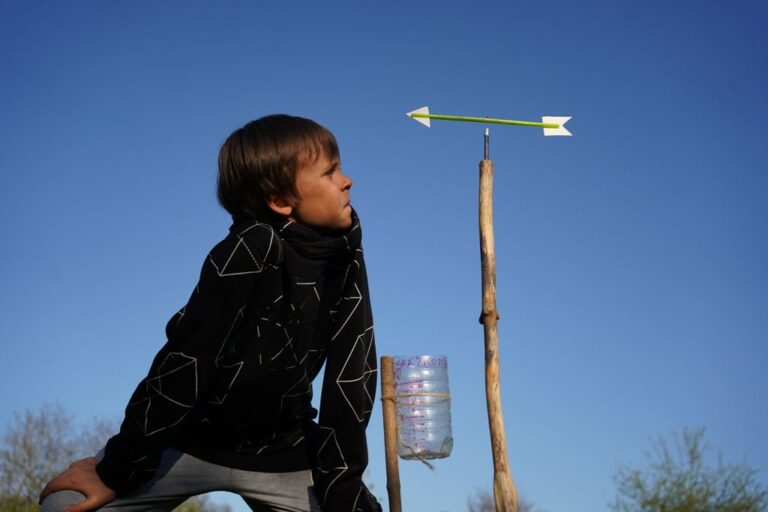
6. Watch the weather for a few days and try to guess the weather
The more we go outside, the better we can sense or estimate the weather. How about a little practice? Focus your attention on the weather and its changes. Write down your weather predictions and then the actual weather for at least a few days. What did you guess correctly and what did you not? Learn to perceive the strength and direction of the wind. The power of the sun. The shapes and colours of the clouds. Some people can also feel the pressure. Develop your sensitivity and judgement. Our ancestors had a lot of use for this skill.

This is a great time to push your mental and physical limits. The summer sun, warm wind in your hair and long days give us the strength to do great things. Push your boundaries and try something new. Become a real experienced outdoor adventurer.
It will help to spend as much time as possible outdoors as well as to keep your eyes and heart open. What starts with hiding a small treasure can end with a big expedition into the wilderness.
Train gradually, safely, but move forward in your ideas of what you can do outside. Nature provides plenty of great space for testing and pushing endurance, for planning, overcoming obstacles and for creativity. All this will come in handy later when you spend more time indoors.
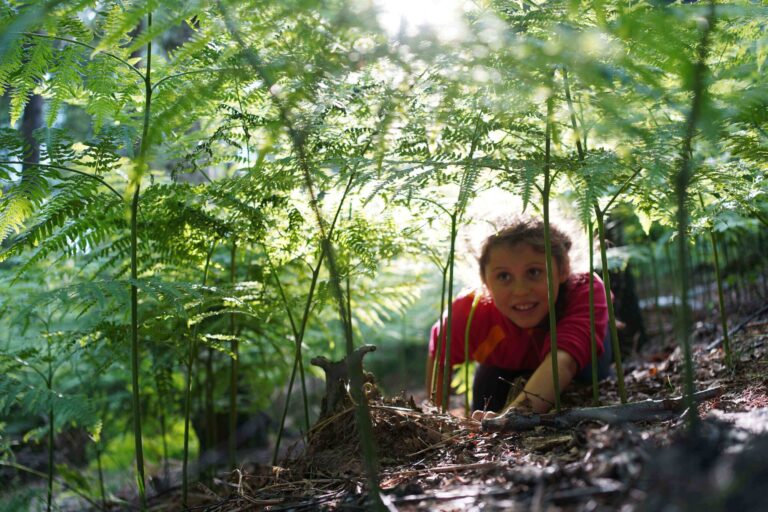
1. Hide the treasure
It's so adventurous. First select a safe and suitable hiding place. Then choose an appropriate precious treasure (something nice, beautiful or tasty) and fit everything in a box, jar or other container. Then secretly stash the newly-created treasure in the hiding place. This treasure can be yours only or hidden for someone else to share or as a gift. Who shall you invite out for a treasure hunt?
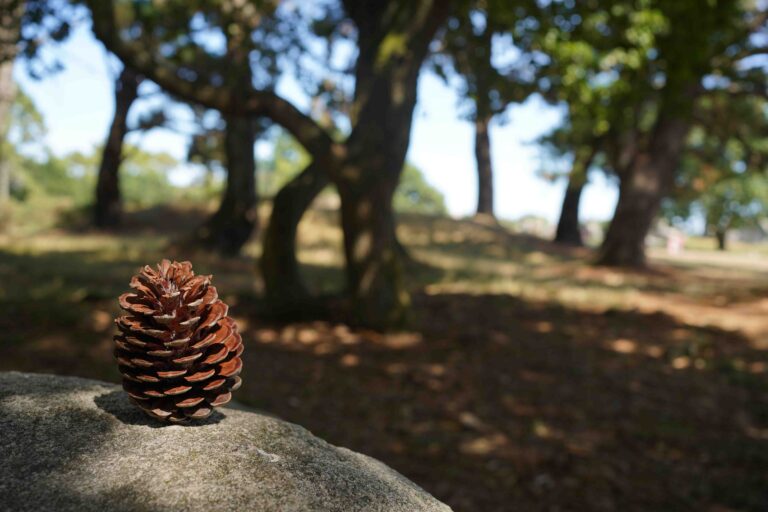
2. Paint a summer treasure map
After hiding the treasure, there is another step for the outdoor adventurer. One simply can not hide a treasure and not draw a treasure map. Where is the treasure hidden and how does one get to it? The map can use secret ciphers, fonts or have tasks. You can smear the map with tea water, fold it, tear its corners to make it look weathered and mysterious. A treasure map is no better invitation to go out and explore.

3. Determine your cardinal points
Find your orientation. Learn to see it in nature. What clues will help you determine north from south, east from west? Get started in well-known places where you know where the sun rises and where it probably sets. If you don't know, you can use a compass. Buildings can help you with direction in the city (for example the orientation of churches). In the wild you can tell direction by looking at plants. The most important thing is to observe and learn. In our lessons you can determine direction using the sun and the hands of a watch.
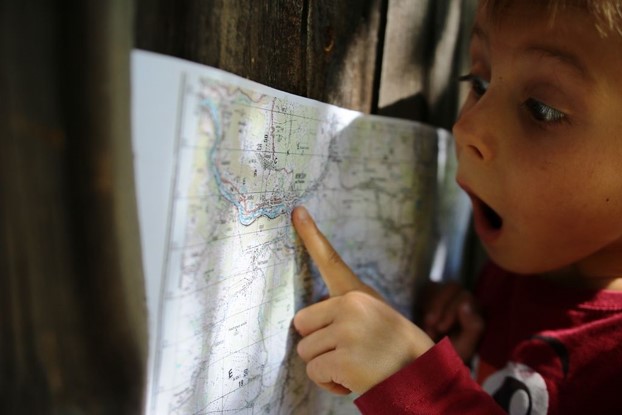
4. Try to take a trip following a map
For some it is trivially simple but for others it can be a real challenge. Try to plan a trip all the while following a map, determined by your possibilities. You can take an easy route or a challenging one over unknown terrain. It is up to you. The key is to improve your skills and boost self-confidence. You can also assemble a party of adventurers for this trip out.
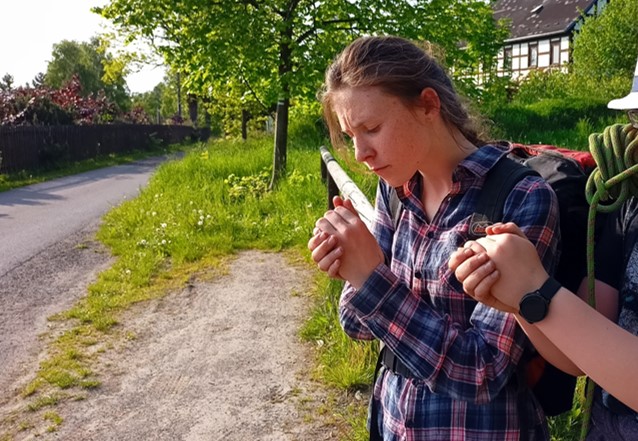
5. Whistle with a straw
This skill will seem easy once you get the hang of it but it needs a great deal of patience. Ideally, find an experienced grass whistler who will show you how to do it and then keep on trying and testing. Once you have mastered grass whistling, try hooting like an owl into your palms or learn some other animal sounds. It can be challenging at times but all the more fun when you master it.
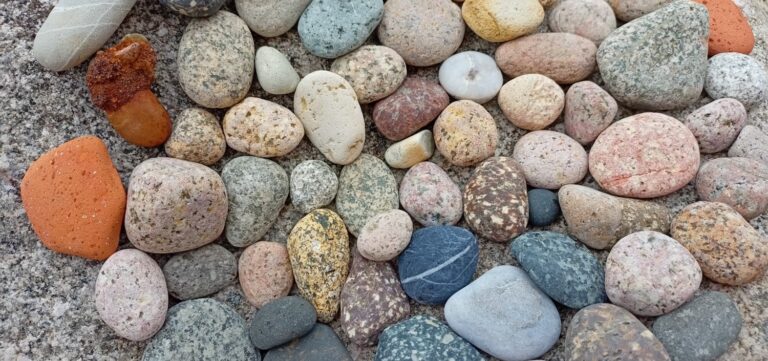
6. Look for fossils and other treasures
Summer is full of stories full of secrets and treasures. Try to visit places where you will discover, by yourself, something new and extraordinary. What you find could be fossils, beautiful pebbles or a driftwood sculpture but you will also find a landscape view, a beautiful place, a rare moment, an encounter with an animal or some other magical moment. Write about your unique moments in nature. They could be the lines from which you can draw strength when gloom and bad moods come to visit during your times spent indoors.

There is perhaps no more relaxed and creative time than summer. See how easy it is to create in the summer. Take a walk through a natural gallery, look around you, perceive shapes, colours, space, materials and get inspired to do your own work.
You can pack a few tools in your knapsack or even bring some natural objects home to use to make wreaths, talismans, sculptures and paintings. What is your favourite material? What do you like to use when crafting? Try as many different materials, styles and crafts as you can. Then you will know what you want to develop further. Creating from nature has one big advantage, you can then return your creation back to nature.
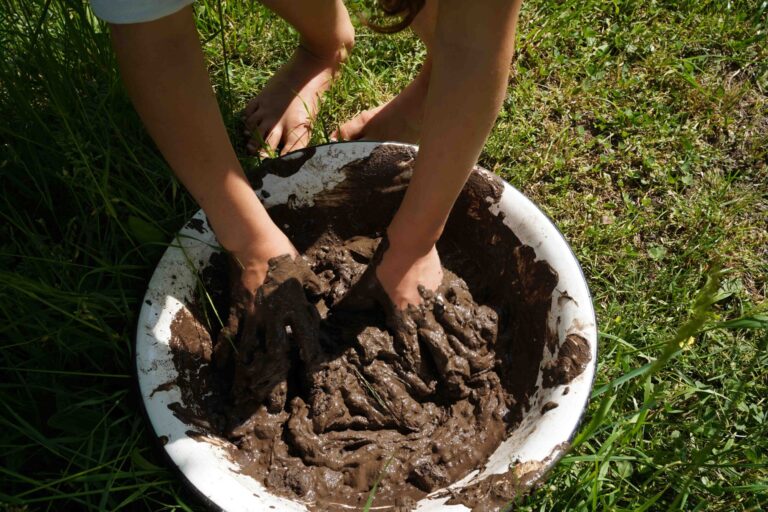
1. Bake mud pies
Surely each of us has baked this delicacy but once is never enough. Summer with its hot days is perfect for mud kitchen baking. Prepare a pliable dough with just the right amount of sticky mud on some sheet metal, a board or flat stump and start forming the base. When it hardens nicely it is time to do the icing and decorating which surely is a favourite part. When everything hardens, you can have a feast and invite guests (family, friends or figurines).
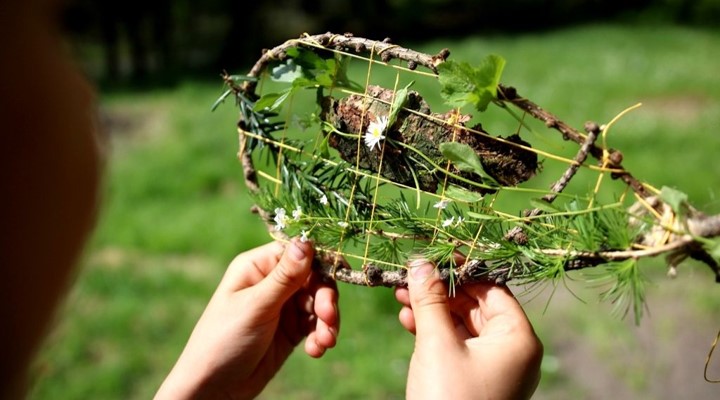
2. Make a tree summer dreamcatcher
Summer dreams are full of unique experiences which makes them worth capturing and keeping for a cloudy day. Make a dreamcatcher outside. Just twist a twig, wrap it with a string, decorate it with some natural materials from your favourite places outside and hang it in a well chosen place. In a tree where you take naps outside is a good spot. You can then take everything with you when you go home.

3. Weave a wreath of herbs or dry summer herbs
Bring the summer and its powers into your home. Decorate your door, window, wall or table with a scented wreath made with natural materials. This creates a beautiful connection between indoor and outdoor space. Make a wreath as a symbol of the circle that is so common in nature. And if you want to perfume your home even more, start drying the herbs that grow around you. Nature has a beautiful rule, which says what grows around you can also heal you. Try daisies, mint, lemon balm, linden, elderberry, nettle, rose and any other herbs that tempt you.

4. Make a talisman with natural materials to wear around your neck
The power of nature will be in all its parts. Prepare yourself for those moments when you aren't in the middle of the wild forces of nature. Make your own personal talisman (from wood, driftwood, pebbles, cones, shells, feathers, etc.). Walk around your favourite places for a while or go on an expedition and wait for your talisman to show itself to you. You can tie it on a string, decorate it, hide it in your pocket or press it. Then carry it with you as often as possible. Trust its power to send you positive energy from nature. It doesn't matter if you lose it. It just means it wants to return to nature and there will always be another one waiting for you elsewhere.

5. Make a musical instrument
Nature is full of sounds and harmonies. Join in the band and make your own musical instrument. It can be a whistle, sounding stick, hanging carillon, wooden or stone xylophone, rattle, lutes, party horns or even drums. You can prepare your own concert or orchestra if there are more of you.
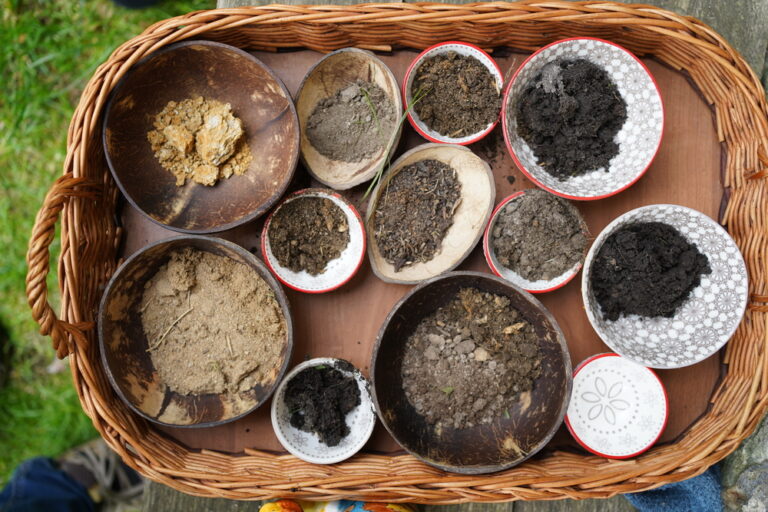
6. Paint a picture with clay paints that you collect
Do you see all the colours of nature around you? This is surely the greatest art of all time.
We can definitely get inspiration but we can also get colours from nature. Try to collect many different shades of soil, clay, mud, sand, dust, pebbles when you are out on an expedition. Keep it all. Then mix it with a little water until you get some gooey paints. Then all you need is paper, canvas, the ground, a tree stump or some stones and you can start painting. Just watch out not to paint on the paths or near the houses of small insects. Let your creations dry in the sun and then hold an art opening in your natural clay gallery.

How many animals are around you right now? Which ones can you see and hear or what other signs of their presence can you detect? What kind of animal will you become in your summer games and travels? In the summer, we manage to slow down our time a little, quiet the inner hustle and bustle and that is when opportunities for beautiful encounters with the animal world can occur. Let yourself be invited into a world full of incredible experiences.
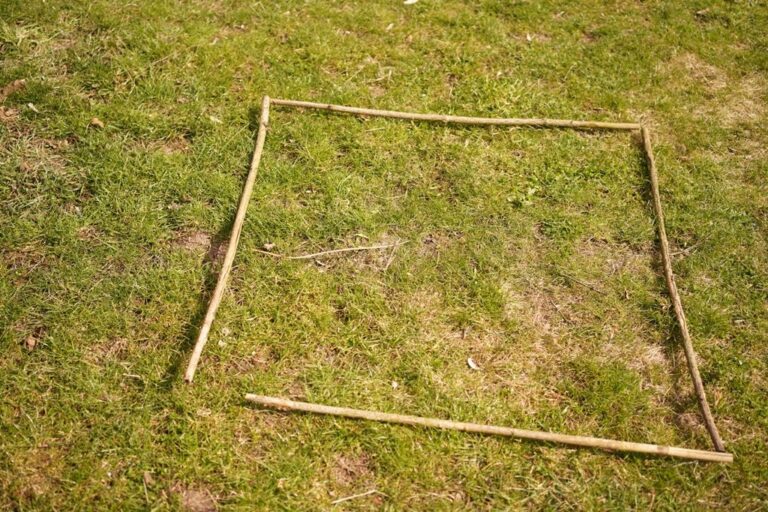
1. Sit on the grass and watch
It may seem trivial, but when was the last time you just sat on some lawn and watched what was going on around you in the grass? Grass, meadow, forest, field, garden, pond, rocks or beach – each of these locations can offer unique glimpses into small worlds of animals. Try marking out a 1x1m area with rope or sticks, make yourself comfortable and watch the area for 10–20 minutes. Maybe a new perspective will open up to you in the places you think you know so well. Here an ant is pulling something up the anthill, there an antlion is waiting in its trap in the sand, water striders are skating on the water surface, a spider is lurking in the flowers… What other dramas or beauty will you discover?

2. Discover your animal neighbours
Are you already a seasoned nature explorer? Try to write down a list of all the animals you find in your area. Look not only at the grass, but also in the crowns of trees, at the tree roots, under stones (careful to return them to their original position), near water, among flowers, in a meadow or in old buildings. You can add pictures to your list. Try to map the animals around you and on your travels. What new ones did you meet?
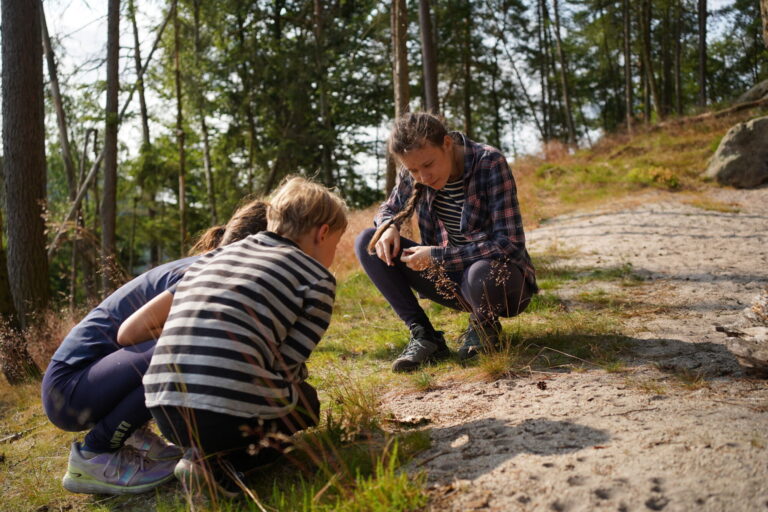
3. Find the signs of wildlife
What are wildlife signs? Everything that can tell us who was here and possibly what they were doing here. Animal tracks are the first that come to mind. You can find them in mud and dry dirt but look quietly and carefully even in hollows and holes in which something might live or take care of their young. Also watch for nests built in branches or on a water's surface. Even "animals' garbage" will tell you a lot – various gnawed remains, disintegrated pine cones, bitten nuts, remnants of feathers. What animals live around you?
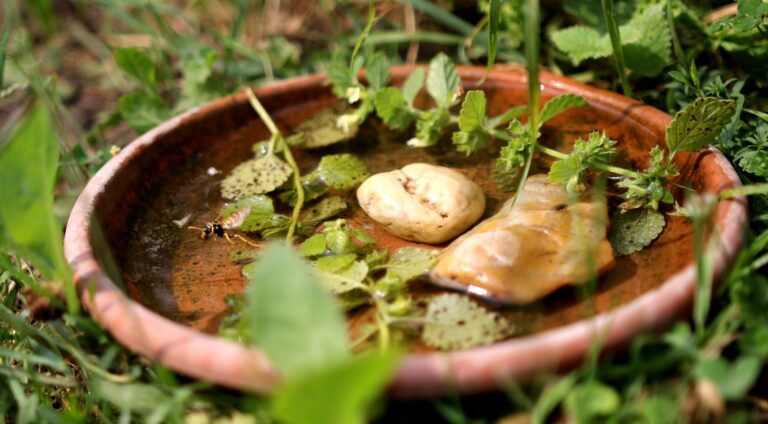
4. Prepare a drinker for insects or birds
Now more than ever, we experience hot days and long periods of drought. Try to provide safe drinking spots wherever possible. Take care of the drinkers regularly so that your animal neighbours have a place to drink from and to bathe in. Most suitable for insects is a shallow dish on the ground, lined with stones or moss so that they don’t drown. If you fill the drinker regularly, hedgehogs and other animals will also come at night. Birds will appreciate a slightly deeper container lined with a few stones and placed somewhere higher in a safe place far from cats.
5. Build a den for an animal
If you enjoy building, you can also build an animal shelter in your area. Choose a good place and decide what will be the most suitable material to use. You can gradually build more houses over the summer. Your animal neighbours will appreciate it. You should definitely build a bird feeder or a birdhouse. For the tiny ones, make an insect house somewhere in the sun where it will be protected from rain. Lizards won't be the only ones that will appreciate a dry pile of stones or a wall and a larger pile of sticks in the sun is great for snakes. An upside-down broken flower pot in a damp place in the shade will be appreciated by frogs. And for the hedgehog? Build a house for a hedgehog for the winter. Discover where else you can help.
6. Follow the development of life outside
They are miraculous moments. They don't often happen right away but when you go out into nature regularly as a quiet observer, you could be a spectator of some wonderful miracles. You can't really plan it, you just have to be there, quiet with your eyes and heart open. This year, my children and I saw an antlion climbing out of its sandhill traps to dry its large wings, in the pond we were watching dragonfly nymphs hunting, we saw damselflies mating, also a young redstart visited us and we watched with bated breath as two male finches fought in flight.

Summer nights are magical, mysterious, even mystical. Their smells, colours, sounds all tell stories. Let the night draw you outside too. How about a short walk or maybe sleep outside in the garden? Another unique world of nightlife comes to life when you sleep outside. It is quite different to perceive nature at night. You will find that familiar places have suddenly completely changed. They differ in sounds, colours and scents. You should try it.

1. Head out in the dark with a head torch
It might seem trite but you should give it a go. After dark, put on your head torch and go out quietly. It opens a whole other window into the wild. It might seem a little scary at first. That is no problem, feel free to sit right outside your door. Eventually you can make your way along a known route. Look around you. What's going on there? How different is it there? You can try turning off the light on your way back (if you want and it's safe).
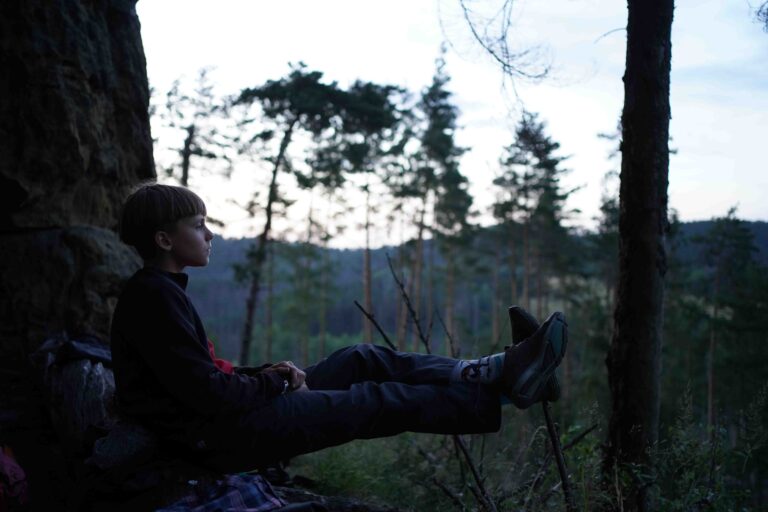
2. Listen and feel the night
Try to perceive the night tonight a little differently. Try to discover the world outside with your ears. Find a pleasant place or a few places. Make yourself comfortable by wrapping yourself in a blanket or a sleeping bag. You can hold the hand of a loved one or be alone. Close your eyes and try to perceive the world around you. What are all the sounds you hear around you? What sounds you hear come from near-by or from far away? Can you smell any new scents? Can you smell an approaching rain, the smell of raspberry, moss, the forest or a fire? Can you feel the night breeze on your face? What else does your skin tell you? What about your “sixth sense”? What does it feel and perceive out in the dark? You can be in the dark, in silence, for just a moment and then go home to talk about your experiences or write them down.
3. Have an evening picnic
Sometimes in the summer waiting for darkness can take a long time. It is a good idea to pass the time with an evening picnic. Go out and collect some goodies in nature or secretly from the pantry at home. Pull out the blanket, lay out the goodies and invite your loved ones. You can eat, chat, read, tell funny or scary stories, play hide and seek or just sit and wait for the coming night.

4. Look up at the starry sky
I don’t know about you, but watching the night sky in the summer is a favourite pastime around here. After a day full of work or summertime fun, it's relaxing to just lie down together and watch the stars appear. Search for constellations. Choose which star is the brightest and imagine which ones could have a planet similar to ours orbiting it. If you are travelling away from home, it is all the more beautiful to see if and how this new night sky differs from the one at home. Can you see the same constellations? Why or why not?
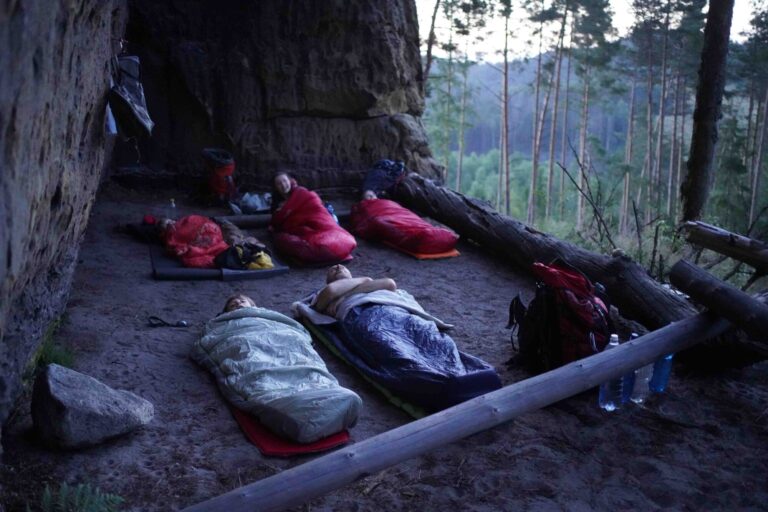
5. Sleep outside
For some it is just a matter of course but for others it is a challenge. Either way, try to sleep outside this year near the house or further afield in a tent or preferably just under the stars. Sleeping outside in places where you will not disturb anything is an amazing opportunity to connect deeply with nature and feel a part of it. Suddenly your senses become sharper and perceive everything much more vividly than when you just visit during a walk. Enjoy your sleep outside.
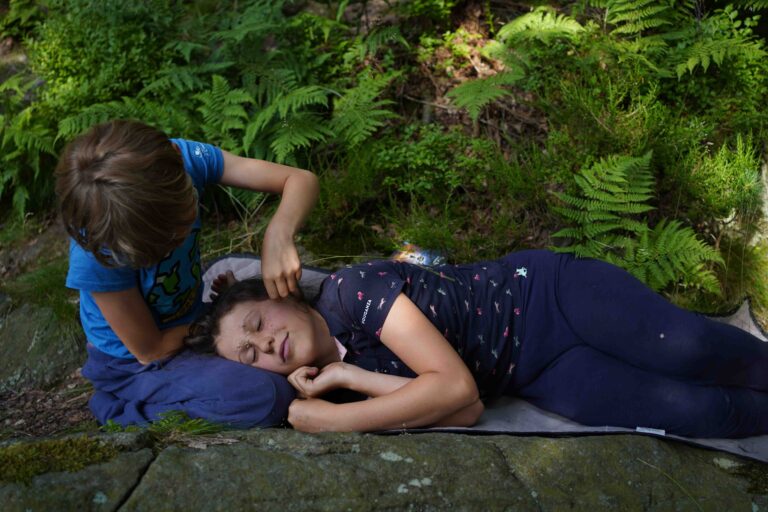
6. Talk about night nature
Sometimes the summer is so full of experiences that during one great moment we can forget others. If you are experiencing a unique summer this year, try to recapture those moments in stories. Tell a loved one about what you experienced, what it was like, what was beautiful or what was a challenge for you. These special moments will become ingrained deeper and all these summer memories will accompany you all year. We recommend writing down your summer stories in a diary if you haven't started to already. Feel free to be detailed, brief or just use pictures. You can add in a natural object or photo. This creates beautiful records of experiences that you can browse even after a long time, perhaps with your children or grandchildren. Then you can invite them outside as well.

During the summer there is enough time for making elaborate constructions. Improve your design skills during these building challenges or make up your own. Ask an adult for help if you need it. Try making something in the workshop with dad, aunt, grandpa. Try working with tools but always consider the safety of yourself and those around you when you do. Many summer games and stories take place in any unique place, whether small or large, bunkers or dens.

1. Build a summer house for elves
You must have already built houses for elves by now but how about taking the elves on a special trip this summer? Try to build a bright summer place in the sun. Or invite a bunch of elves to an adventure summer camp. Perhaps they will appreciate a deep hidden den in the shadows or a small solid log cabin out in the open. Perhaps they want to go to the water or far away. You can also invent a story about what they will experience during construction. Prepare a studio, training ground, playground or a sports field for them. Do your elves like to play pétanque or do they prefer marbles or football? Do they want to fly in a balloon or launch boats in the stream? Create a world for them according to their ideas.
2. Build a small bridge
Here is the technical construction challenge. Look for a suitable place in the vicinity – a puddle, a stream, a hole or other uneven obstacle – and build a bridge over it. It is up to you which style you choose, whether it is a suspension bridge, footbridge, a cantilever bridge, a bridge with several pillars… it is up to you. Use twigs, sticks, bark or stones. You can build using only natural materials or you can add ropes, wires, cardboard, etc. The more natural the better because then you don't have to cart everything unnatural away with you. Try your hand at building a small tower with natural materials next.
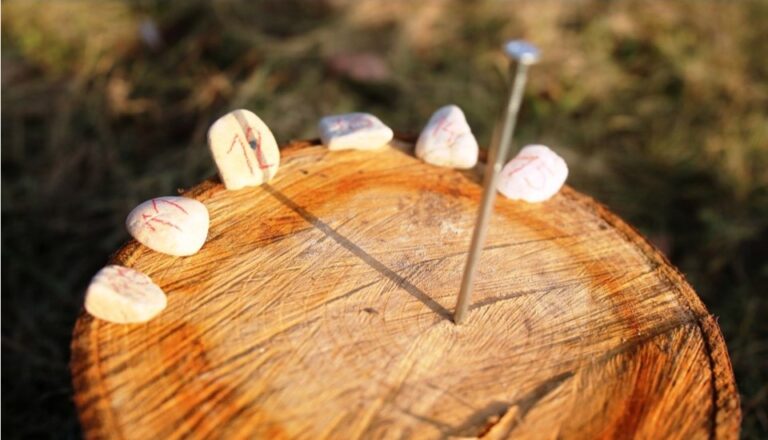
3. Make a sundial
Easy for some but for others it is a research challenge lasting several days. Try to build a clock that is as functional as possible. Choose a suitable place where the sun shines all day. It can be on the ground or on a wall. Centre your gnomon (a rod, stick, branch or skewer, depending on the size of your clock, that casts the shadow) oriented towards the south (or north in the southern hemisphere). Now during a sunny day, watch the dial from the morning and note where the shadow falls and when. You can use stones or sticks to mark the hours. For example, at 9:00 place a stone with the number nine on it where the shadow is pointing, at 10:00 mark the place of the shadow with a number 10 and so on. The next day try to check if everything works. You can paint a temporary clock on the wall or on pavement with chalk.
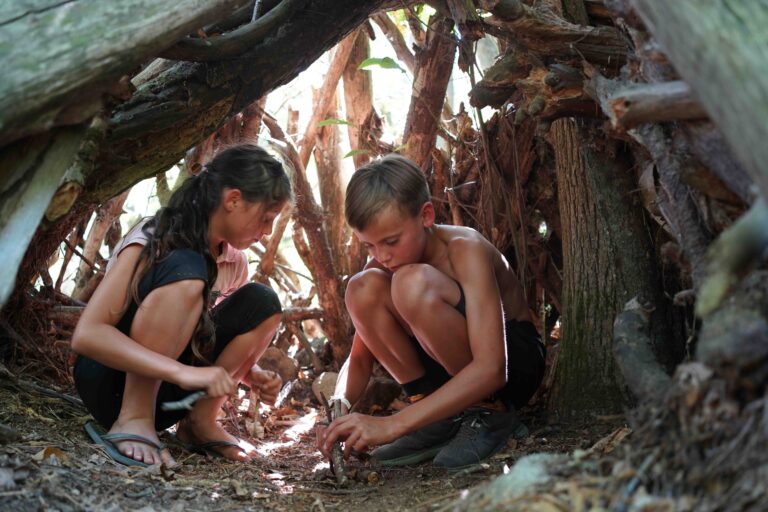
4. Build your own den
This is a favourite challenge. Summer dens are unique, full of adventure and stories. First choose a suitable location, individually or in the group. It needs to be a little out of the way or totally hidden. Then simply plan what and how you will build. Discuss your plan with a trusted adult to see if it's okay. Ready the necessary materials (strings, saw, tarpaulin, blankets, planks... don't forget a supply of water and food). Inconspicuously transfer the building materials to the den site and construction can start. It is clear that during construction the plans might change and there will be quibbles and mistakes at times but that's all part of it. It is ideal to be building and using the den for a longer period of time, ideally the whole summer or the whole week you are at grandma's. You can also come up with a name for it and add camouflage and a password to enter, paint a map, sleep there and much more.
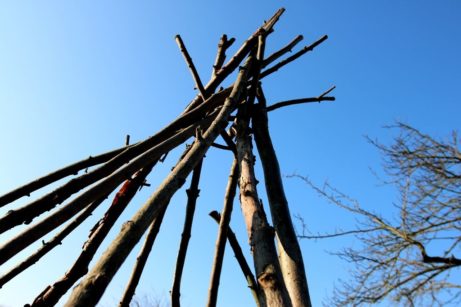
5. Build a tipi or other shelter against the sun
It seems like an easy construction, but it requires a little practice and knowledge of the movements of the sun. For the tipi you will need long thin poles or branches (ideally 1.5–2.5m long). Smaller ones are good enough for a more simple shelter. The poles stand in a circle or semicircle, tie the tips at the top or intertwine them. The skeleton will be ready to wrap with a sheet or some blankets. You can attach the covering with pegs or string. On the ground you can add cardboard or a mat and a blanket. A smaller shelter can be transported or moved as the glare of the sun moves. Once finished, the games or relaxation can begin.
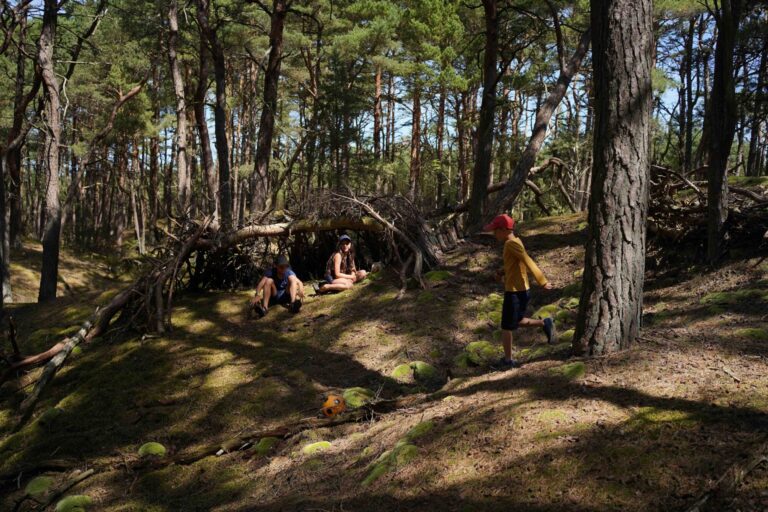
6. Try to build a place to sleep
Maybe you've already spent the night outside and you know what it's like to experience morning dew or light rain. Use your engineering skills and build a simple shelter outside to sleep in. Find a suitable place where you can stay overnight. Prepare a tarpaulin, strings, ropes (shock cords are great). Build a shelter keeping it low to the ground and try it out. Ideally also in the rain just to make sure your construction went well. If it's not raining, you can water the tarpaulin lightly from a watering can and observe where the water flows. An even bigger challenge is to build a functional shelter for the night using only natural materials.

Don't be afraid to get into a fight. Playful adrenaline is a big part of summer. Fighting is a big part of playing so definitely add some battle elements to your games. Ideally, find a group to get into it with you. Playful fighting can also be just in our imaginations like when you have to save a mythical unicorn but you can also organise a battle game in the real world as long as you all enjoy the rampaging and keep smiles on your faces. That's the only way to enjoy summer fighting games often and to your heart's content.

1. Have a pinecone battle
This sort of battle is easy, fast and tempting. Find a suitable place (ideally a spruce or pine forest). It is very important to first agree on who wants and who does not want to play and setting limits on how hard to throw and where on the body to aim (it is good to exclude headshots) and whether it is only played for fun or if you're playing to win something. Once that is decided, just quickly collect some ammunition, divide the teams and away you go.
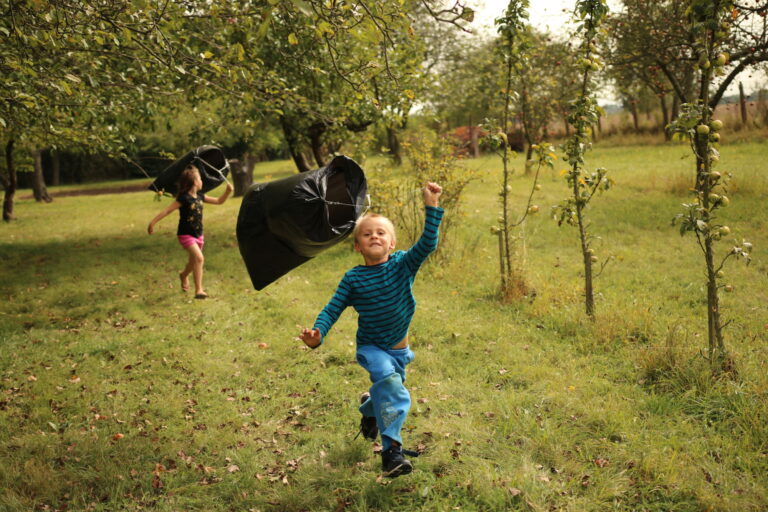
2. Follow the wind and invite it to play
Maybe you prefer to take on the natural elements. So how about packing up a scarf or bag and heading outside? Tie the scarf on a stick and the bag on a string and run out into the wind. Test how and where it is strong, and where it is weaker. If you don't have a scarf or a bag, you can throw fluff in the wind and observe where and how far it will fly.
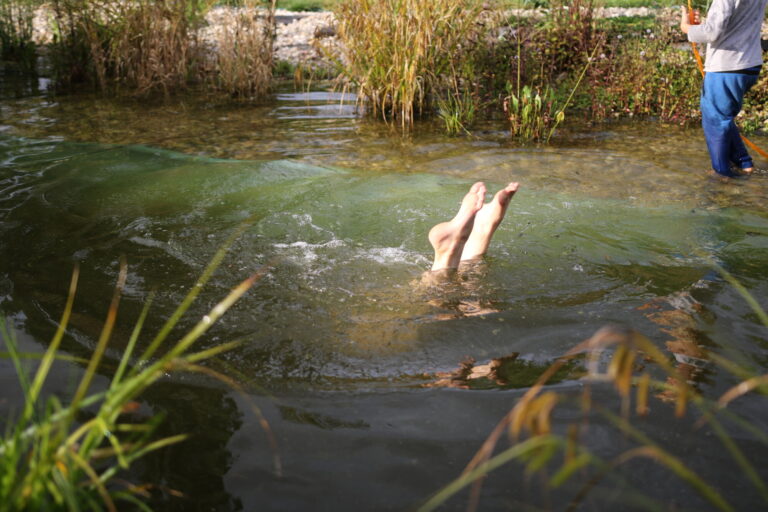
3. Try some stealthy creeping
The ability to move silently in nature definitely comes in handy. Improve your stealth skills. Choose a place where you can pass as quietly as possible and then try to sneak about. Finally, challenge yourself to "rob" something good at home, unnoticed of course. You could ask someone to sit outside, with a book for example, while you try to approach them silently. During the summer you can perfect moving silently through nature.
4. Have water battles
This is an ideal relaxation on hot days. You can battle waves, splashes, a sprinkler or a hose. It is usually more fun in a group. Try to "fight" in the waves together, splash each other, spray each other with water guns or make your own from a PET bottle. Punch a hole in its cap with a nail, then just squeeze the bottle to shoot water and it's time to attack. Feel free to just enjoy the water but you can also appoint team territories, a treasure or basic rules of battle.

5. Make weapons for mammoth hunters
We love summer reading together. Choose a beautiful adventure story and then experience it again and again by developing it into summer games and trips. We often make props and sometimes weapons (for defence only). Try making a spear from a straight stick. An axe made of stone or cardboard embedded in a split stick. You might also be able to handle swords, a slingshot, a fishing harpoon, a bow and arrows (always think about the safety of yourself and your surroundings). You can hang a bag on a tree and train with weapons for a while every day. All weapons should only be pretend as our imaginations will take care of everything else.
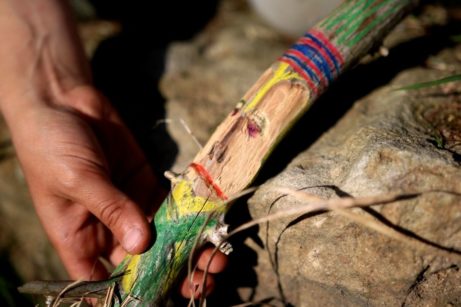
6. Build a totem pole
Do you have a favourite natural spot? Have you had many adventures outside? Maybe it's now time to build your own natural symbol. How it looks will be up to you. Whether it will be a painted stick or a trunk, small or large, carved from wood, modelled from clay, assembled from stones… It's really up to you. Make it your own. How do you want to express what this place means to you and what you experience there? You can always improve it gradually or change it completely. You can have it out in the open or hide it from view.

Trees and their shade are essential for us in the summer. They are often oases where we go to cool off and hide from the heat of the sun. They are also places full of life, where you can observe what lives there and how. And of course, they are great for climbing, for watchtowers or supports for our hiding places and dens. Visit the trees a little more often this summer.
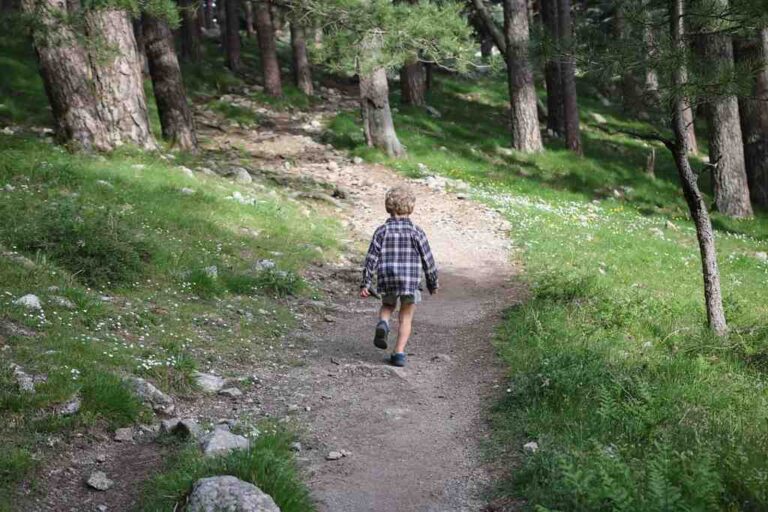
1. Walk around and observe some trees
The shade of the trees is a pleasant place to walk in the summer. Try to wander around some trees and focus your attention on their crowns, branches, flowers or fruits, trunk, hollows and roots. What is the light, shadow and fragrance like under them? What are they like to touch?
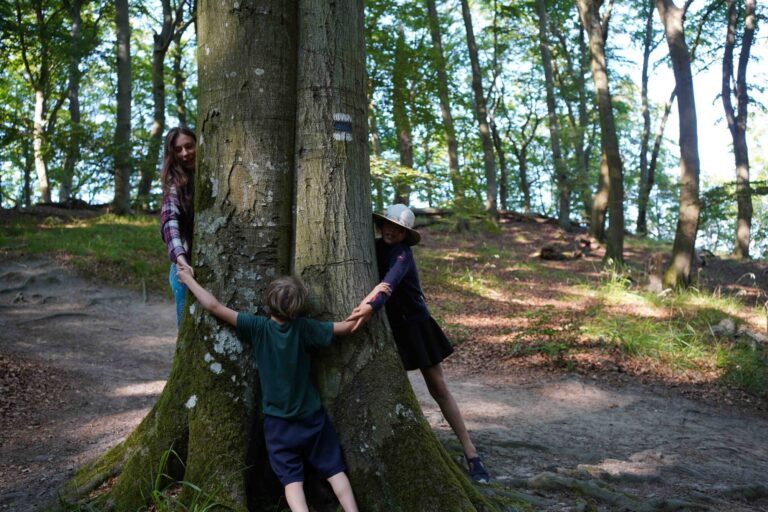
2. Find your favourite tree
As you walk among the trees, try to pick one that you want to return to. Maybe it is nice to sit under it or it is great to build houses for elves there. Maybe it is great for climbing or it has a perfect big branch for a swing. You can also come up with a name for your favourite tree, paint it and try to think how old it is. What did it experience and feel during its life? Make up the story of its life.
3. Examine the bark of trees
Today, on a trip to your favourite tree, bring your favourite little figurine or animal. Explore the tree bark together. How rugged or rough is it, how many furrows does it have? Who lives here and what grows here? How does it feel to touch it? Can your figurine hide here? Compare different types of trees. How does tree bark differ? If you don't know, you can read a book called Toby Alone.
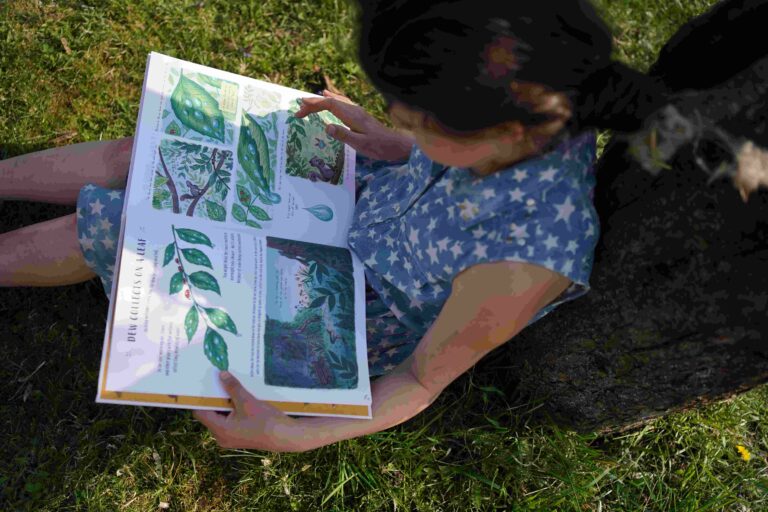
4. Take your favourite thing to read and read it under a tree
Sometimes it's so hot outside that you don't want to do anything. This is an ideal opportunity to pack a blanket, a book, and something tasty in your backpack and set off to your favourite tree. Sit among its roots, on a branch or lean against a trunk and start reading. Some people prefer to make up their own stories under the tree or draw pictures or comics. It's up to you. Just try to enjoy a peaceful time.
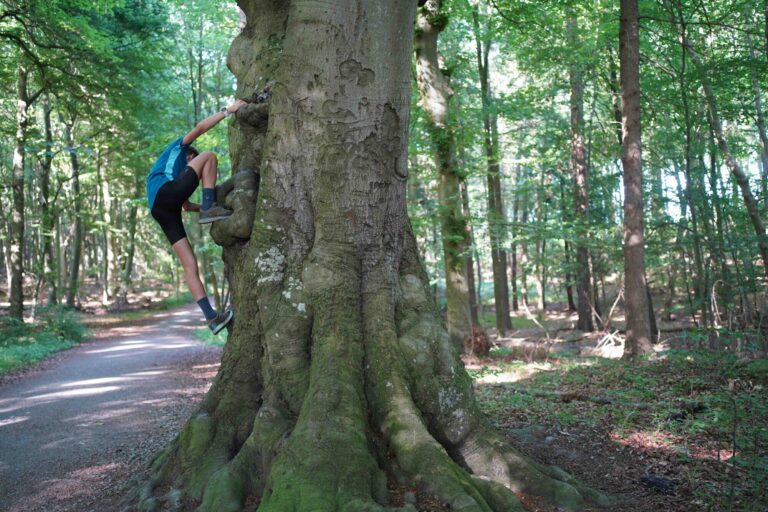
5. Climb a sturdy tree and look out at the world from its branches
There is a difference between observing a tree from the ground with your head turned up or sitting high in the crown on a branch – being a part of the tree's life. Suddenly, everything that happens here is more intense and you are closer to it. Try to find a suitable tree and climb to the centre of the crown where possible (again think about your safety and the safety of the tree). Take a seat (you can also pack a pillow or hammock and a snack). Watch who climbs, flies, sings and searches for food. See how the wind blows here? How do the leaves flutter? Watch as the rays of the sun flicker through the crown.

6. Examine an old tree
People often cut down injured or old trees. Finding a grandfather tree is sometimes a challenge. There are not many around us very often and yet they are essential for the diversity of nature. They give shelter to so many animals, plants and fungi. They return nutrients back to the soil from which they were taken in their course of life. They also retain stored carbon dioxide which would otherwise be sent into the atmosphere if they were burned (contributing to greater climate change). Try to look for and observe old, injured and fallen trees on your summer expeditions. Follow who lives there and what happens.
how to build sensitivity to nature
We are here to help you with that task. Just choose one of our e-books - children will be playing and learning at the same time!

SUMMER CHALLENGES ARE BROUGHT TO YOU BY


ANNA Fischerová
networker, methodologist, creator, tester, actionwoman, coordinator


ADÉLA Hamplová
lecturer, practitioner, creator, tester, networker, actionwoman, teacher


JUSTINA Danišová
creator, lecturer, teacher, lesson author and tester, dreamer



ALENA and KEN
Schagen
an amazing translation team who translates and fine-tunes our texts into their final shape


SHARE YOUR EXPERIENCE
Inspire people around you by videos, photographs, results, advice and questions:
on Facebook
by e-mail at team@lessonsingrass.com

WE WANT TO GET CHILDREN OUT
We can help you on the way out too
